Asymmetric Synthesis of Tetrasubstituted α-Aminophosphonic Acid Derivatives
Abstract
:1. Introduction
2. Diastereoselective Synthesis of Tetrasubstituted α-Aminophosphonic Acid Derivatives
2.1. C-C Bond Formation
2.2. C-P Bond Formation
2.3. C-N Bond Formation
3. Enantioselective Synthesis of Tetrasubstituted α-Aminophosphonic Acid Derivatives
3.1. C-C Bond Formation
3.2. C-P Bond Formation
3.3. C-N Bond Formation
4. Final Remarks
Author Contributions
Funding
Institutional Review Board Statement
Informed Consent Statement
Data Availability Statement
Conflicts of Interest
References
- Duthaler, R.O. Recent developments in the stereoselective synthesis of α-aminoacids. Tetrahedron 1994, 50, 1539–1650. [Google Scholar] [CrossRef]
- Nájera, C.; Sansano, J.M. Catalytic asymmetric synthesis of α-amino acids. Chem. Rev. 2007, 107, 4584–4671. [Google Scholar] [CrossRef]
- O’Donnell, M.J. The enantioselective synthesis of α-amino acids by phase-transfer catalysis with achiral Schiff base esters. Acc. Chem. Res. 2004, 37, 506–517. [Google Scholar] [CrossRef]
- Berlicki, L.; Kafarski, P. Computer-Aided Analysis and Design of Phosphonic and Phosphinic Enzyme Inhibitors as Potential Drugs and Agrochemicals. Curr. Org. Chem. 2005, 9, 1829–1850. [Google Scholar] [CrossRef]
- Sieńczyk, M.; Winiarski, Ł.; Kasperkiewicz, P.; Psurski, M.; Wietrzyk, J.; Oleksyszyn, J. Simple phosphonic inhibitors of human neutrophil elastase. Bioorg. Med. Chem. Lett. 2011, 21, 1310–1314. [Google Scholar] [CrossRef]
- Vassiliou, S.; Węglarz-Tomczak, E.; Berlicki, Ł.; Pawełczak, M.; Nocek, B.; Mulligan, R.; Joachimiak, A.; Mucha, A. Structure-guided, single-point modifications in the phosphinic dipeptide structure yield highly potent and selective inhibitors of neutral aminopeptidases. J. Med. Chem. 2014, 57, 8140–8151. [Google Scholar] [CrossRef] [PubMed]
- Arya, T.; Reddi, R.; Kishor, C.; Ganji, R.J.; Bhukya, S.; Gumpena, R.; McGowan, S.; Drag, M.; Addlagatta, A. Identification of the molecular basis of inhibitor selectivity between the human and streptococcal type i methionine aminopeptidases. J. Med. Chem. 2015, 58, 2350–2357. [Google Scholar] [CrossRef]
- Veera Narayana Reddy, M.; Balakrishna, A.; Anil Kumar, M.; Chandra Sekhar Reddy, G.; Uma Ravi Sankar, A.; Suresh Reddy, C.; Murali Krishna, T. One-step synthesis and bioassay of N-phosphoramidophosphonates. Chem. Pharm. Bull. 2009, 57, 1391–1395. [Google Scholar] [CrossRef] [PubMed] [Green Version]
- Che, J.Y.; Xu, X.Y.; Tang, Z.L.; Gu, Y.C.; Shi, D.Q. Synthesis and herbicidal activity evaluation of novel α-amino phosphonate derivatives containing a uracil moiety. Bioorg. Med. Chem. Lett. 2016, 26, 1310–1313. [Google Scholar] [CrossRef]
- Narayana Reddy, M.V.; Siva Kumar, B.; Balakrishna, A.; Reddy, C.S.; Nayak, S.K.; Reddya, C.D. One-pot synthesis of novel α-amino phosphonates using tetramethylguanidine as a catalyst. Arkivoc 2007, 2007, 246–254. [Google Scholar] [CrossRef] [Green Version]
- Dake, S.A.; Raut, D.S.; Kharat, K.R.; Mhaske, R.S.; Deshmukh, S.U.; Pawar, R.P. Ionic liquid promoted synthesis, antibacterial and in vitro antiproliferative activity of novel α-aminophosphonate derivatives. Bioorg. Med. Chem. Lett. 2011, 21, 2527–2532. [Google Scholar] [CrossRef]
- Sivala, M.R.; Devineni, S.R.; Golla, M.; Medarametla, V.; Pothuru, G.K.; Chamarthi, N.R. A heterogeneous catalyst, SiO2-ZnBr2: An efficient neat access for α-aminophosphonates and antimicrobial activity evaluation. J. Chem. Sci. 2016, 128, 1303–1313. [Google Scholar] [CrossRef] [Green Version]
- Rao, K.U.M.; Swapna, S.; Manidhar, D.M.; Reddy, K.M.K.; Reddy, C.S. Efficient synthesis of α-aminophosphonates and evaluation of significance of PO group towards antioxidant activity. Phosphorus Sulfur Silicon Relat. Elem. 2015, 190, 232–239. [Google Scholar] [CrossRef]
- Cassien, M.; Petrocchi, C.; Thétiot-Laurent, S.; Robin, M.; Ricquebourg, E.; Kandouli, C.; Asteian, A.; Rockenbauer, A.; Mercier, A.; Culcasi, M.; et al. On the vasoprotective mechanisms underlying novel β-phosphorylated nitrones: Focus on free radical characterization, scavenging and NO-donation in a biological model of oxidative stress. Eur. J. Med. Chem. 2016, 119, 197–217. [Google Scholar] [CrossRef] [PubMed] [Green Version]
- Damiche, R.; Chafaa, S. Synthesis of new bioactive aminophosphonates and study of their antioxidant, anti-inflammatory and antibacterial activities as well the assessment of their toxicological activity. J. Mol. Struct. 2017, 1130, 1009–1017. [Google Scholar] [CrossRef]
- Li, Y.J.; Wang, C.Y.; Ye, M.Y.; Yao, G.Y.; Wang, H.S. Novel coumarin-containing aminophosphonatesas antitumor agent: Synthesis, cytotoxicity, DNA-Binding and apoptosis evaluation. Molecules 2015, 20, 14791–14809. [Google Scholar] [CrossRef] [Green Version]
- Huang, R.Z.; Wang, C.Y.; Li, J.F.; Yao, G.Y.; Pan, Y.M.; Ye, M.Y.; Wang, H.S.; Zhang, Y. Synthesis, antiproliferative and apoptosis-inducing effects of novel asiatic acid derivatives containing α-aminophosphonates. RSC Adv. 2016, 6, 62890–62906. [Google Scholar] [CrossRef]
- Wang, Q.; Yang, L.; Ding, H.; Chen, X.; Wang, H.; Tang, X. Synthesis, X-ray crystal structure, DNA/protein binding and cytotoxicity studies of five α-aminophosphonate N-derivatives. Bioorg. Chem. 2016, 69, 132–139. [Google Scholar] [CrossRef]
- Stamper, C.; Bennett, B.; Edwards, T.; Holz, R.C.; Ringe, D.; Petsko, G. Inhibition of the aminopeptidase from Aeromonas proteolytica by l-leucinephosphonic acid. Spectroscopic and crystallographic characterization of the transition state of peptide hydrolysis. Biochemistry 2001, 40, 7035–7046. [Google Scholar] [CrossRef]
- Kafarski, P.; Lejczak, B.; Szewczyk, J. Optically active 1-aminoalkanephosphonic acids. Dibenzoyl-l-tartaric anhydride as an effective agent for the resolution of racemic diphenyl 1-aminoalkanephosphonates. Can. J. Chem. 1983, 61, 2425–2430. [Google Scholar] [CrossRef]
- Solodenko, V.A.; Kukhar, V.P. Stereoselective papain-catalyzed Synthesis of Alafosfalin. Tetrahedron Lett. 1989, 30, 6917–6918. [Google Scholar] [CrossRef]
- Poliak, M.S. Antibiotics of the phosphonic acid group. Antibiot. Med Biotechnol. 1987, 32, 66–75. [Google Scholar]
- Ordóñez, M.; Sayago, F.J.; Cativiela, C. Synthesis of quaternary α-aminophosphonic acids. Tetrahedron 2012, 68, 6369–6412. [Google Scholar] [CrossRef]
- Bera, K.; Namboothiri, I.N.N. Asymmetric Synthesis of Quaternary α-Amino Acids and Their Phosphonate Analogues. Asian J. Org. Chem. 2014, 3, 1234–1260. [Google Scholar] [CrossRef]
- Shimizu, M. Construction of asymmetric quaternary carbon centers with high enantioselectivity. Angew. Chem. Int. Ed. 2011, 50, 5998–6000. [Google Scholar] [CrossRef]
- Hawner, C.; Alexakis, A. Metal-catalyzed asymmetric conjugate addition reaction: Formation of quaternary stereocenters. Chem. Commun. 2010, 46, 7295–7306. [Google Scholar] [CrossRef] [PubMed]
- Christoffers, J.; Baro, A. Quaternary Stereocenters: Challenges and Solutions for Organic Synthesis; John Wiley & Sons: Hoboken, NJ, USA, 2006; ISBN 3527311076. [Google Scholar]
- Riant, O.; Hannedouche, J. Asymmetric catalysis for the construction of quaternary carbon centres: Nucleophilic addition on ketones and ketimines. Org. Biomol. Chem. 2007, 5, 873–888. [Google Scholar] [CrossRef] [PubMed]
- Studer, A.; Seebach, D. Preparation of either enantiomer of 1,2-diaminoalkane-2-phosphonic acid derivatives. Heterocycles 1995, 40, 357–378. [Google Scholar] [CrossRef]
- Fitzi, R.; Seebach, D. Resolution and use in α-amino acid synthesis of imidazolidinone glycine derivatives. Tetrahedron 1988, 44, 5277–5292. [Google Scholar] [CrossRef]
- Schickll, C.P.; Seebach, D. Preparation of Chiral Electrophilic Glycine and (E)-2, 3-Dehydroamino Acid Derivatives from tert.-Butyl 2-tert.-Butyl-3-methyl-4-oxo-1-imidazolidinecarboxylate (Boc-BMI). ChemInform 1991, 22, 655–668. [Google Scholar] [CrossRef]
- Davis, F.A.; Wu, Y.; Xu, H.; Zhang, J. Asymmetric synthesis of cis-5-substituted pyrrolidine 2-phosphonates using metal carbenoid NH insertion and δ-amino β-ketophosphonates. Org. Lett. 2004, 6, 4523–4525. [Google Scholar] [CrossRef]
- Davis, F.A.; Xu, H.; Wu, Y.; Zhang, J. Asymmetric synthesis of polyfunctionalized pyrrolidines from sulfinimine-derived pyrrolidine 2-phosphonates. Synthesis of pyrrolidine 225C. Org. Lett. 2006, 8, 2273–2276. [Google Scholar] [CrossRef] [PubMed] [Green Version]
- Katritzky, A.R.; Cui, X.L.; Yang, B.; Steel, P.J. Asymmetric syntheses of 2-substituted and 2,5-disubstituted pyrrolidines from (3S,5R,7aR)-5-(benzotriazol-1-yl)-3-phenyl[2,1-b]oxazolopyrrolidine. J. Org. Chem. 1999, 64, 1979–1985. [Google Scholar] [CrossRef] [PubMed]
- Amedjkouh, M.; Westerlund, K. Self-reproduction of chirality on α-aminophosphonates: Asymmetric synthesis of α-alkylated diethyl pyrrolidin-2-yl-phosphonate. Tetrahedron Lett. 2004, 45, 5175–5177. [Google Scholar] [CrossRef]
- Vicario, J.; Ortiz, P.; Palacios, F. Synthesis of tetrasubstituted α-aminophosphonic acid derivatives from trisubstituted α-aminophosphonates. Eur. J. Org. Chem. 2013, 7095–7100. [Google Scholar] [CrossRef]
- Rassukana, Y.V.; Stanko, O.V.; Onys’ko, P.P. Enantiomeric O,O-dimenthyl α-iminotrifluoroethylphosphonates: Novel chiral building blocks in asymmetric synthesis of α-trifluoromethylated α-aminophosphonic acid derivatives. J. Fluor. Chem. 2019, 219, 123–128. [Google Scholar] [CrossRef]
- Rassukana, Y.V.; Bezgubenko, L.V.; Stanko, O.V.; Rusanov, E.B.; Kulik, I.B.; Onys’ko, P.P. Diastereoselective cycloaddition of (S)-N-(1-phenylethylimino)trifluoropropionate and trifluoroethylphosphonate with diazomethane. Tetrahedron Asymmetry 2017, 28, 555–560. [Google Scholar] [CrossRef]
- Davis, F.A.; Lee, S.; Yan, H.; Titus, D.D. Asymmetric Synthesis of Quaternary α-Amino Phosphonates Using Sulfinimines. Org. Lett. 2001, 3, 1757–1760. [Google Scholar] [CrossRef]
- Davis, F.A.; Lee, S.H.; Xu, H. Asymmetric synthesis of cyclic α-amino phosphonates using masked oxo sulfinimines (N-sulfinyl imines). J. Org. Chem. 2004, 69, 3774–3781. [Google Scholar] [CrossRef]
- Chen, Q.; Yuan, C. A new and convenient asymmetric synthesis of α-amino- and α-alkyl-α-aminophosphonic acids using N-tert-butylsulfinyl imines as chiral auxiliaries. Synthesis 2007, 24, 3779–3786. [Google Scholar] [CrossRef]
- Chen, Q.; Li, J.; Yuan, C. Sulfinimine-mediated asymmetric synthesis of acyclic and cyclic α-aminophosphonates. Synthesis 2008, 18, 2986–2990. [Google Scholar] [CrossRef]
- Khan, H.A.; Ellman, J.A. Asymmetric synthesis of α-aminophosphonate esters by the addition of dialkyl phosphites to tert-butanesulfinyl imines. Synthesis 2013, 45, 3147–3150. [Google Scholar] [CrossRef]
- Li, P.; Jiang, M.; Liu, J.T. Asymmetric Pudovik Reaction of Chiral Fluoroalkyl α,β-Unsaturated Ketimines and Diphenyl Phosphite. Chin. J. Chem. 2014, 32, 1003–1006. [Google Scholar] [CrossRef]
- Pedroni, J.; Cramer, N. Enantioselective C–H Functionalization—Addition Sequence Delivers Densely Substituted 3-Azabicyclo[3.1.0]hexanes. J. Am. Chem. Soc. 2017, 139, 12398–12401. [Google Scholar] [CrossRef] [PubMed]
- Fadel, A.; Tesson, N. Synthesis of enantiomerically pure (1S,2S)-1-aminocyclopropanephosphonic acids from (2S)-methylcyclopropanone acetal. Eur. J. Org. Chem. 2000, 2153–2159. [Google Scholar] [CrossRef]
- Tesson, N.; Dorigneux, B.; Fadel, A. Synthesis of (1S,2S)- and (1R,2R)-1-amino-2-methylcyclopropane-phosphonic acids from racemic methylcyclopropanone acetal. Tetrahedron Asymmetry 2002, 13, 2267–2276. [Google Scholar] [CrossRef]
- Fadel, A.; Tesson, N. Preparation of enantiomerically pure (1S,2S)-1-aminocyclopropanephosphonic acid from methylcyclopropanone acetal via spirophosphonate intermediates. Tetrahedron Asymmetry 2000, 11, 2023–2031. [Google Scholar] [CrossRef]
- Louaisil, N.; Rabasso, N.; Fadel, A. Asymmetric synthesis of (R)- and (S)-α-amino-3-piperidinylphosphonic acids via phosphite addition to iminium ions. Synthesis 2007, 2, 289–293. [Google Scholar] [CrossRef]
- Louaisil, N.; Rabasso, N.; Fadel, A. Highly stereoselective synthesis of new α-amino-β-hydroxy six-membered heterocyclic phosphonic acids, serine analogues. Tetrahedron 2009, 65, 8587–8595. [Google Scholar] [CrossRef]
- Iwanejko, J.; Brol, A.; Szyja, B.M.; Daszkiewicz, M.; Wojaczyńska, E.; Olszewski, T.K. Aminophosphonates and aminophosphonic acids with tetrasubstituted stereogenic center: Diastereoselective synthesis from cyclic ketimines. Org. Biomol. Chem. 2019, 17, 7352–7359. [Google Scholar] [CrossRef]
- Iwanejko, J.; Sowiński, M.; Wojaczyńska, E.; Olszewski, T.K.; Górecki, M. An approach to new chiral bicyclic imines and amines: Via Horner-Wadsworth-Emmons reaction. RSC Adv. 2020, 10, 14618–14629. [Google Scholar] [CrossRef] [Green Version]
- Fang, Z.; Yang, H.; Miao, Z.; Chen, R. Asymmetric Mannich-type synthesis of N-phosphinyl α-aminophosphonic acid monoesters. Helv. Chim. Acta 2011, 94, 1586–1593. [Google Scholar] [CrossRef]
- Kuliszewska, E.; Hanbauer, M.; Hammerschmidt, F. Preparation of α-aminobenzylphosphonic acids with a stereogenic quaternary carbon atom via microscopically configurationally stable α-aminobenzyllithiums. Chem. Eur. J. 2008, 14, 8603–8614. [Google Scholar] [CrossRef] [PubMed]
- Qian, R.; Roller, A.; Hammerschmidt, F. Phosphonate-phosphinate rearrangement. J. Org. Chem. 2015, 80, 1082–1091. [Google Scholar] [CrossRef] [PubMed]
- Davis, F.A.; McCoull, W.; Titus, D.D. Asymmetric synthesis of α-methylphosphophenylalanine derivatives using sulfinimine-derived enantiopure aziridine-2-phosphonates. Org. Lett. 1999, 1, 1053–1055. [Google Scholar] [CrossRef] [PubMed]
- Hercouet, A.; Le Corre, M.; Carboni, B. Asymmetric synthesis of a phosphonic analogue of (−)-allo-norcoronamic acid. Tetrahedron Lett. 2000, 41, 197–199. [Google Scholar] [CrossRef]
- Sawamura, M.; Hamashima, H.; Ito, Y. Rhodium-catalyzed enantioselective Michael addition of (1-cyanoethyl) phosphonate: Synthesis of optically active phosphonic acid derivatives with phosphorus-substituted quaternary asymmetric carbon center. Bull. Chem. Soc. Jpn. 2000, 73, 2559–2562. [Google Scholar] [CrossRef]
- Wąsek, K.; Kędzia, J.; Krawczyk, H. An efficient approach to the synthesis of enantiomerically pure trans-1-amino-2-(hydroxymethyl)cyclopropanephosphonic acids. Tetrahedron Asymmetry 2010, 21, 2081–2086. [Google Scholar] [CrossRef]
- Kuwano, R.; Nishio, R.; Ito, Y. Enantioselective construction of quaternary α-carbon centers on α-amino phosphonates via catalytic asymmetric allylation. Org. Lett. 1999, 1, 837–839. [Google Scholar] [CrossRef]
- Wilt, J.C.; Pink, M.; Johnston, J.N. A diastereo- and enantioselective synthesis of α-substituted anti-α,β-diaminophosphonic acid derivatives. Chem. Commun. 2008, 4177–4179. [Google Scholar] [CrossRef]
- Bera, K.; Namboothiri, I.N.N. Enantioselective synthesis of quaternary α-aminophosphonates via conjugate addition of α-nitrophosphonates to enones. Org. Lett. 2012, 14, 980–983. [Google Scholar] [CrossRef]
- Bera, K.; Namboothiri, I.N.N. Quinine-derived thiourea and squaramide catalyzed conjugate addition of α-nitrophosphonates to enones: Asymmetric synthesis of quaternary α-aminophosphonates. J. Org. Chem. 2015, 80, 1402–1413. [Google Scholar] [CrossRef] [PubMed]
- Pham, T.S.; Gönczi, K.; Kardos, G.; Süle, K.; Hegedus, L.; Kállay, M.; Kubinyi, M.; Szabó, P.; Petneházy, I.; Toke, L.; et al. Cinchona based squaramide catalysed enantioselective Michael addition of α-nitrophosphonates to aryl acrylates: Enantioselective synthesis of quaternary α-aminophosphonates. Tetrahedron Asymmetry 2013, 24, 1605–1614. [Google Scholar] [CrossRef] [Green Version]
- Tripathi, C.B.; Kayal, S.; Mukherjee, S. Catalytic asymmetric synthesis of α,β-disubstituted α,γ-diaminophosphonic acid precursors by michael addition of α-substituted nitrophosphonates to nitroolefins. Org. Lett. 2012, 14, 3296–3299. [Google Scholar] [CrossRef]
- Bera, K.; Namboothiri, I.N.N. Enantioselective synthesis of α-amino-γ-sulfonyl phosphonates with a tetrasubstituted chiral α-carbon via quinine-squaramide-catalyzed michael addition of nitrophosphonates to vinyl sulfones. Adv. Synth. Catal. 2013, 355, 1265–1270. [Google Scholar] [CrossRef]
- Chen, G.Y.; Lu, Y. Highly enantioselective Michael addition of α-substituted nitrophosphonates to a vinyl sulfone. Synthesis 2013, 45, 1654–1658. [Google Scholar] [CrossRef] [Green Version]
- Han, W.Y.; Zhao, J.Q.; Wu, Z.J.; Zhang, X.M.; Yuan, W.C. Asymmetric synthesis of β-hydroxy-α-amino phosphonic acid derivatives via organocatalytic direct aldol reaction of α-isothiocyanato phosphonates with aldehydes. J. Org. Chem. 2013, 78, 10541–10547. [Google Scholar] [CrossRef] [PubMed]
- Cao, Y.M.; Shen, F.F.; Zhang, F.T.; Zhang, J.L.; Wang, R. Catalytic asymmetric 1,2-addition of α-isothiocyanato phosphonates: Synthesis of chiral β-hydroxy- or β-amino-substituted α-amino phosphonic acid derivatives. Angew. Chem. Int. Ed. 2014, 53, 1862–1866. [Google Scholar] [CrossRef]
- Frankowski, S.; Gajda, T.; Albrecht, Ł. Isothiocyanate Strategy for the Synthesis of Quaternary α-Amino Acids Bearing a Spirocyclic Ring System. Adv. Synth. Catal. 2018, 360, 1822–1832. [Google Scholar] [CrossRef]
- Maestro, A.; de Marigorta, E.M.; Palacios, F.; Vicario, J. α-Iminophosphonates: Useful Intermediates for Enantioselective Synthesis of α-Aminophosphonates. Asian J. Org. Chem. 2020, 9, 538–548. [Google Scholar] [CrossRef]
- Sekine, M.; Kume, A.; Hata, T. Dialkyl acylphosphonates: A new acylating agent of alcohols. Tetrahedron Lett. 1981, 22, 3617–3620. [Google Scholar] [CrossRef]
- Vicario, J.; Ezpeleta, J.M.; Palacios, F. Asymmetric cyanation of a-ketiminophosphonates catalyzed by Cinchona alkaloids: Enantioselective synthesis of tetrasubstituted a-aminophosphonic acid derivatives from trisubstituted a-aminophosphonates. Adv. Synth. Catal. 2012, 354, 2641–2647. [Google Scholar] [CrossRef]
- Vicario, J.; Ortiz, P.; Ezpeleta, J.M.; Palacios, F. Asymmetric synthesis of functionalized tetrasubstituted α-aminophosphonates through enantioselective aza-Henry reaction of phosphorylated ketimines. J. Org. Chem. 2015, 80, 156–164. [Google Scholar] [CrossRef]
- Maestro, A.; del Corte, X.; Martinez de Marigorta, E.; Palacios, F.; Vicario, J. Enantioselective synthesis of functionalized αα-aminophosphonic acid derivatives. Phosphorus Sulfur Silicon Relat. Elem. 2019, 194, 287–291. [Google Scholar] [CrossRef]
- Maestro, A.; Martinez de Marigorta, E.; Palacios, F.; Vicario, J. Enantioselective Aza-Reformatsky Reaction with Ketimines. Org. Lett. 2019, 21, 9473–9477. [Google Scholar] [CrossRef]
- Rassukana, Y.V.; Yelenich, I.P.; Vlasenko, Y.G.; Onys’ko, P.P. Asymmetric synthesis of phosphonotrifluoroalanine derivatives via proline-catalyzed direct enantioselective CC bond formation reactions of NH trifluoroacetimidoyl phosphonate. Tetrahedron Asymmetry 2014, 25, 1234–1238. [Google Scholar] [CrossRef]
- Morisaki, K.; Sawa, M.; Yonesaki, R.; Morimoto, H.; Mashima, K.; Ohshima, T. Mechanistic Studies and Expansion of the Substrate Scope of Direct Enantioselective Alkynylation of α-Ketiminoesters Catalyzed by Adaptable (Phebox)Rhodium(III) Complexes. J. Am. Chem. Soc. 2016, 138, 6194–6203. [Google Scholar] [CrossRef] [PubMed]
- Zhou, C.Y.; Wang, J.C.; Wei, J.; Xu, Z.J.; Guo, Z.; Low, K.H.; Che, C.M. Dirhodium carboxylates catalyzed enantioselective coupling reactions of α-diazophosphonates, anilines, and electron-deficient aldehydes. Angew. Chem. Int. Ed. 2012, 51, 11376–11380. [Google Scholar] [CrossRef] [PubMed]
- Yan, Z.; Wu, B.; Gao, X.; Zhou, Y.G. Enantioselective synthesis of quaternary α-aminophosphonates by Pd-catalyzed arylation of cyclic α-ketiminophosphonates with arylboronic acids. Chem. Commun. 2016, 52, 10882–10885. [Google Scholar] [CrossRef]
- Yan, Z.; Gao, X.; Zhou, Y.G. Enantioselective synthesis of quaternary α-aminophosphonates by organocatalytic Friedel-Crafts reactions of indoles with cyclic α-ketiminophosphonates. Chin. J. Catal. 2017, 38, 784–791. [Google Scholar] [CrossRef]
- Shao, Q.; Wu, L.; Chen, J.; Gridnev, I.D.; Yang, G.; Xie, F.; Zhang, W. Copper (II)/RuPHOX-Catalyzed Enantioselective Mannich-Type Reaction of Glycine Schiff Bases with Cyclic Ketimines. Adv. Synth. Catal. 2018, 360, 4625–4633. [Google Scholar] [CrossRef]
- Liu, Y.J.; Li, J.S.; Nie, J.; Ma, J.A. Organocatalytic Asymmetric Decarboxylative Mannich Reaction of β-Keto Acids with Cyclic α-Ketiminophosphonates: Access to Quaternary α-Aminophosphonates. Org. Lett. 2018, 20, 3643–3646. [Google Scholar] [CrossRef]
- Yamashita, Y.; Imaizumi, T.; Guo, X.X.; Kobayashi, S. Chiral silver amides as effective catalysts for enantioselective [3+2] cycloaddition reactions. Chem. Asian J. 2011, 6, 2550–2559. [Google Scholar] [CrossRef]
- Huang, N.; Tong, X.; Zhou, S.; Guo, Q.; Peng, Y. Asymmetric [3+2] Cycloaddition Reactions of α-Substituted Diazophosphonates with 3-Acryloyl-2-oxazolidinone to Access Chiral Pyrazoline Derivatives with Phosphonyl at a Tetrasubstituted Stereogenic Center. Adv. Synth. Catal. 2019, 361, 4805–4810. [Google Scholar] [CrossRef]
- Sun, J.; Mou, C.; Liu, C.; Huang, R.; Zhang, S.; Zheng, P.; Chi, Y.R. Enantioselective access to multi-cyclic α-amino phosphonates: Via carbene-catalyzed cycloaddition reactions between enals and six-membered cyclic imines. Org. Chem. Front. 2018, 5, 2992–2996. [Google Scholar] [CrossRef]
- Sun, J.; Mou, C.; Wang, Z.; He, F.; Wu, J.; Chi, Y.R. Carbene-Catalyzed [4+2] Cycloadditions of Vinyl Enolate and (in Situ Generated) Imines for Enantioselective Synthesis of Quaternary α-Amino Phosphonates. Org. Lett. 2018, 20, 5969–5972. [Google Scholar] [CrossRef] [PubMed]
- Luo, Z.; Gao, Z.H.; Zhang, C.L.; Chen, K.Q.; Ye, S. Enantioselective Synthesis of Cyclic α-Aminophosphonates through N-Heterocyclic Carbene-Catalyzed [4+2] Annulation of Enals with α-Iminophosphonates. Asian J. Org. Chem. 2018, 7, 2452–2455. [Google Scholar] [CrossRef]
- Sasai, H.; Arai, S.; Tahara, Y.; Shibasaki, M. Catalytic Asymmetric Synthesis of a-Amino Phosphonates Using Lanthanoid-Potassium-BINOL Complexes. J. Org. Chem. 1995, 60, 6656–6657. [Google Scholar] [CrossRef]
- Merino, P.; Marqués-López, E.; Herrera, R.P. Catalytic enantioselective hydrophosphonylation of aldehydes and imines. Adv. Synth. Catal. 2008, 350, 1195–1208. [Google Scholar] [CrossRef] [Green Version]
- Bhadury, P.S.; Li, H. Organocatalytic asymmetric hydrophosphonylation/Mannich reactions using thiourea, cinchona and brnsted acid catalysts. Synlett 2012, 23, 1108–1131. [Google Scholar] [CrossRef]
- Spilling, C.D.; Malla, R.K. Synthesis of Non-Racemic α-Hydroxyphosphonates via Asymmetric Phospho-Aldol Reaction; Springer: Berlin/Heidelberg, Germany, 2015; Volume 361, ISBN 978-3-540-73346-1. [Google Scholar]
- Nakamura, S.; Hayashi, M.; Hiramatsu, Y.; Shibata, N.; Funahashi, Y.; Toru, T. Catalytic enantioselective hydrophosphonylation of ketimines using cinchona alkaloids. J. Am. Chem. Soc. 2009, 131, 18240–18241. [Google Scholar] [CrossRef]
- Yin, L.; Bao, Y.; Kumagai, N.; Shibasaki, M. Catalytic asymmetric hydrophosphonylation of ketimines. J. Am. Chem. Soc. 2013, 135, 10338–10341. [Google Scholar] [CrossRef] [PubMed]
- Lin, S.; Otsuka, Y.; Yin, L.; Kumagai, N.; Shibasaki, M. Catalytic Enantioselective Addition of Diethyl Phosphite to N-Thiophosphinoyl Ketimines: Preparation of (R)-Diethyl (1-Amino-1-phenylethyl)phosphonate. Org. Synth. 2017, 94, 313–331. [Google Scholar] [CrossRef] [Green Version]
- Robertson, G.P.; Farley, A.J.M.; Dixon, D.J. Bifunctional Iminophosphorane Catalyzed Enantioselective Ketimine Phospha-Mannich Reaction. Synlett 2016, 27, 21–24. [Google Scholar] [CrossRef] [Green Version]
- Xie, H.; Song, A.; Zhang, X.; Chen, X.; Li, H.; Sheng, C.; Wang, W. Quinine-thiourea catalyzed enantioselective hydrophosphonylation of trifluoromethyl 2(1H)-quinazolinones. Chem. Commun. 2013, 49, 928–930. [Google Scholar] [CrossRef] [PubMed]
- George, J.; Sridhar, B.; Reddy, B.V.S. First example of quinine-squaramide catalyzed enantioselective addition of diphenyl phosphite to ketimines derived from isatins. Org. Biomol. Chem. 2014, 12, 1595–1602. [Google Scholar] [CrossRef]
- Kumar, A.; Sharma, V.; Kaur, J.; Kumar, V.; Mahajan, S.; Kumar, N.; Chimni, S.S. Cinchona-derived thiourea catalyzed hydrophosphonylation of ketiminesdan enantioselective synthesis of α-amino phosphonates. Tetrahedron 2014, 70, 7044–7049. [Google Scholar] [CrossRef]
- Jang, H.S.; Kim, Y.; Kim, D.Y. Enantioselective addition of diphenyl phosphonate to ketimines derived from isatins catalyzed by binaphthyl-modified organocatalysts. Beilstein J. Org. Chem. 2016, 12, 1551–1556. [Google Scholar] [CrossRef] [Green Version]
- Nazish, M.; Jakhar, A.; Khan, N.U.H.; Verma, S.; Kureshy, R.I.; Abdi, S.H.R.; Bajaj, H.C. Enantioselective hydrophosphonylation of N-benzyl imines, isatin derived ketimines and isatins catalyzed by in-situ generated Ti(IV) macrocyclic salen complexes. Appl. Catal. A Gen. 2016, 515, 116–125. [Google Scholar] [CrossRef]
- Suneja, A.; Unhale, R.A.; Singh, V.K. Enantioselective Hydrophosphonylation of in Situ Generated N-Acyl Ketimines Catalyzed by BINOL-Derived Phosphoric Acid. Org. Lett. 2017, 19, 476–479. [Google Scholar] [CrossRef]
- Nakamura, S.; Hayama, D. Enantioselective Reaction of 2H-Azirines with Phosphite Using Chiral Bis(imidazoline)/Zinc(II) Catalysts. Angew. Chem. Int. Ed. 2017, 56, 8785–8789. [Google Scholar] [CrossRef] [PubMed]
- Bernardi, L.; Zhuang, W.; Jørgensen, K.A. An easy approach to optically active α-amino phosphonic acid derivatives by chiral Zn(II)-catalyzed enantioselective amination of phosphonates. J. Am. Chem. Soc. 2005, 127, 5772–5773. [Google Scholar] [CrossRef] [PubMed]
- Kim, S.M.; Kim, H.R.; Kim, Y.K. Catalytic enantioselective fluorination and amination of β-keto phosphonates catalyzed by chiral palladium complexes. Org. Lett. 2005, 7, 2309–2311. [Google Scholar] [CrossRef] [PubMed]
- de Fusco, C.; Fuoco, T.; Croce, G.; Lattanzi, A. Noncovalent organocatalytic synthesis of enantioenriched terminal aziridines with a quaternary stereogenic center. Org. Lett. 2012, 14, 4078–4081. [Google Scholar] [CrossRef] [PubMed]

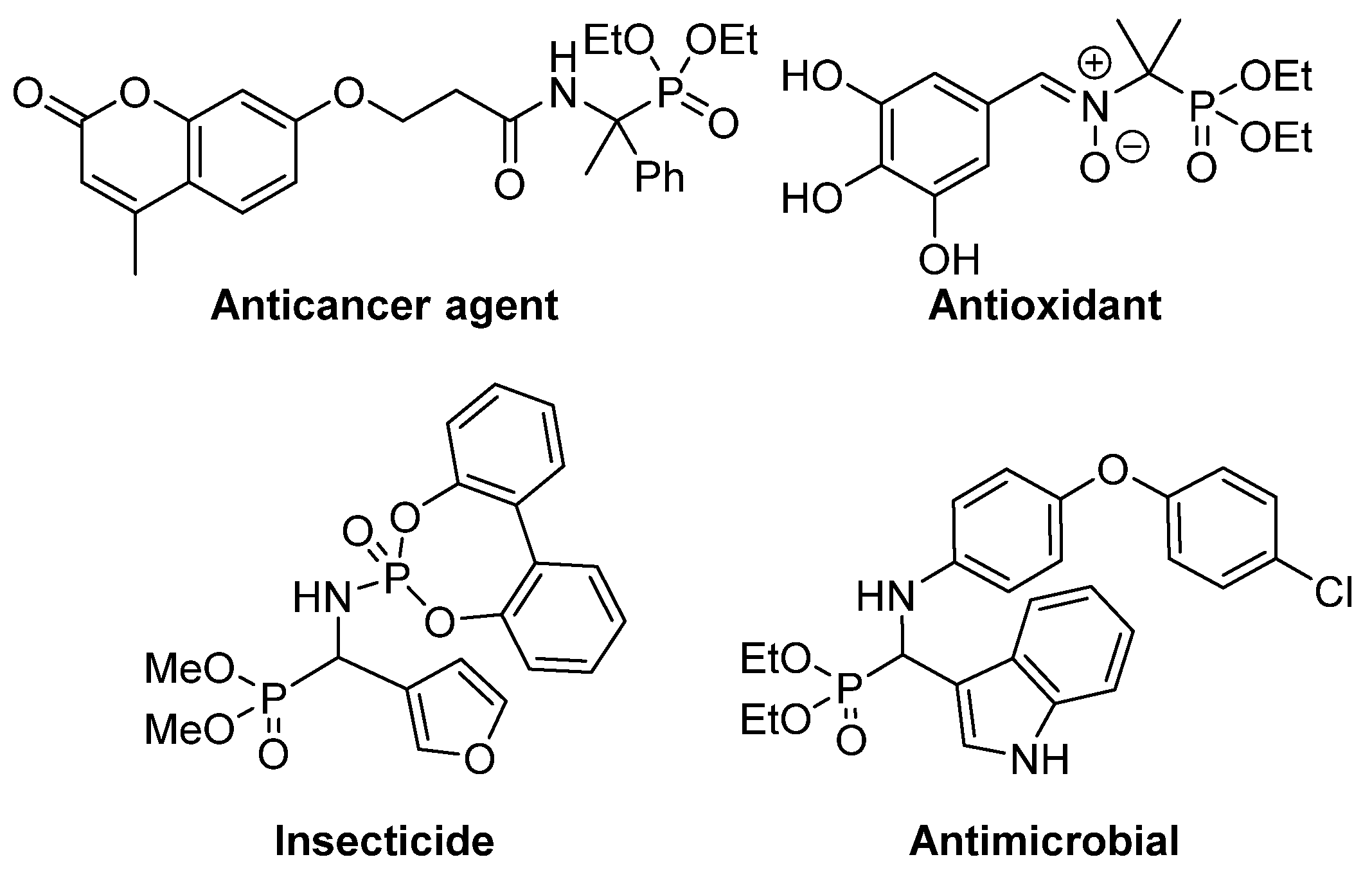
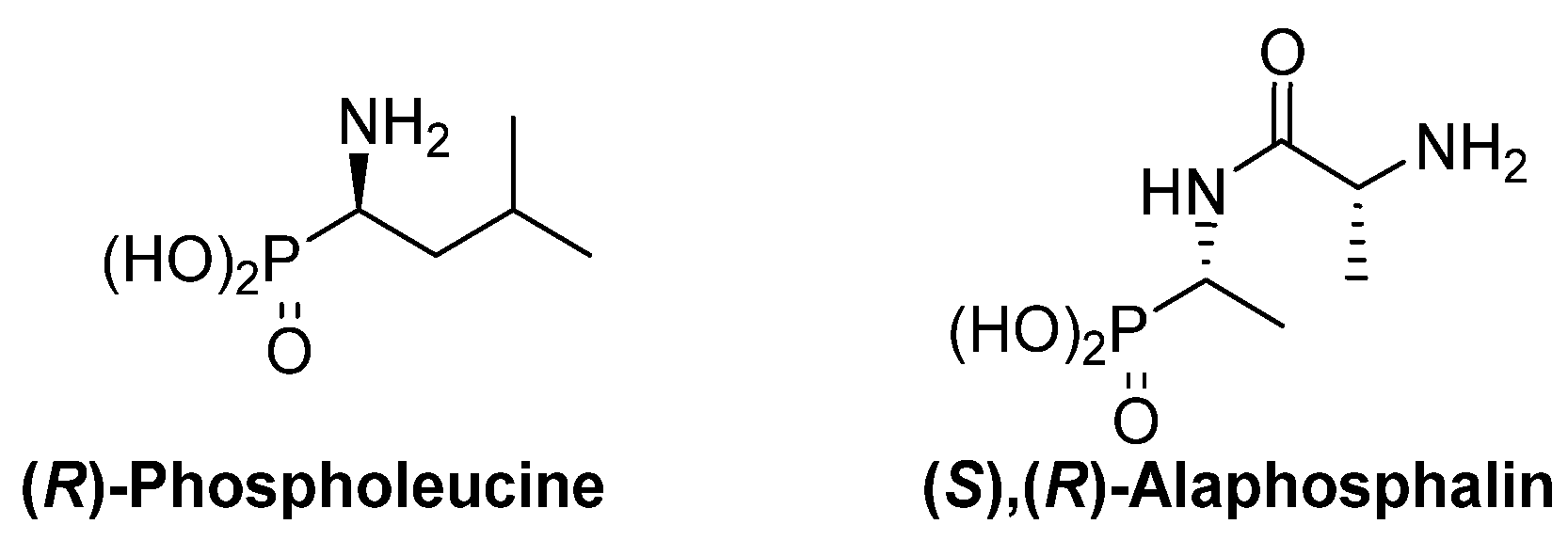
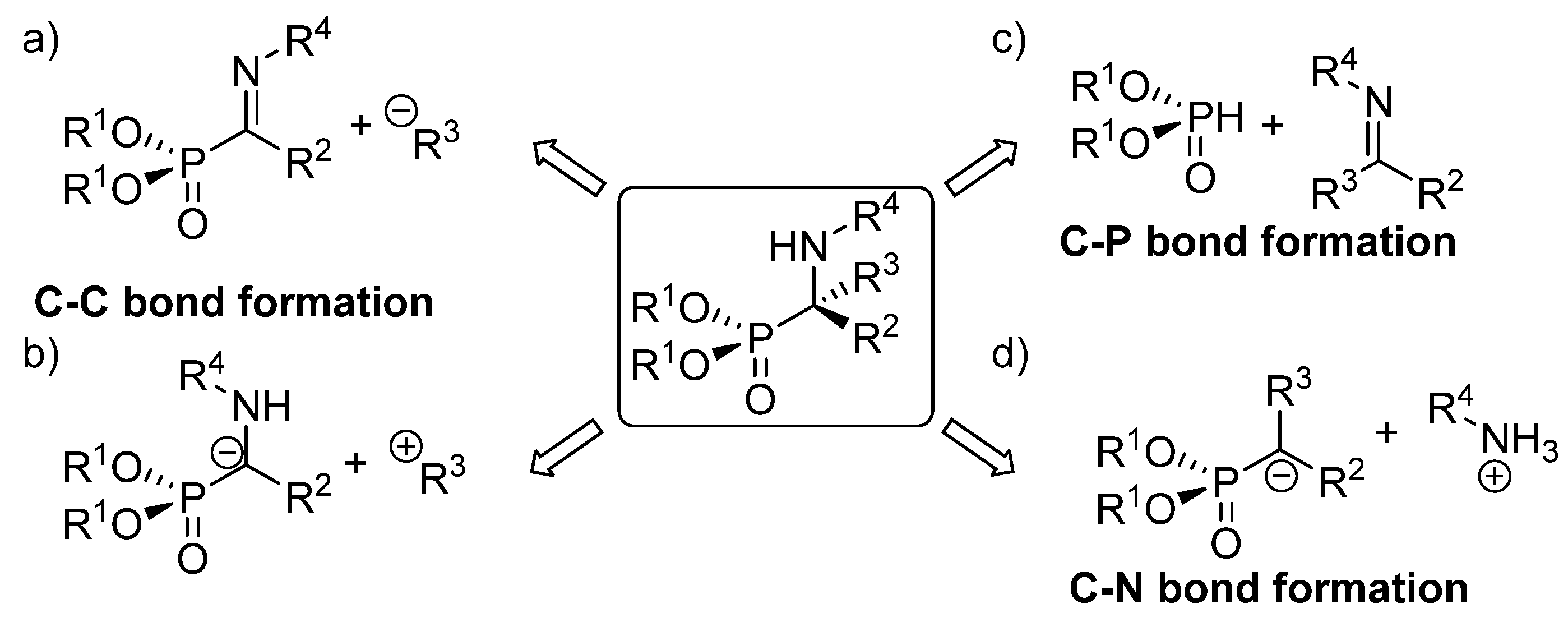

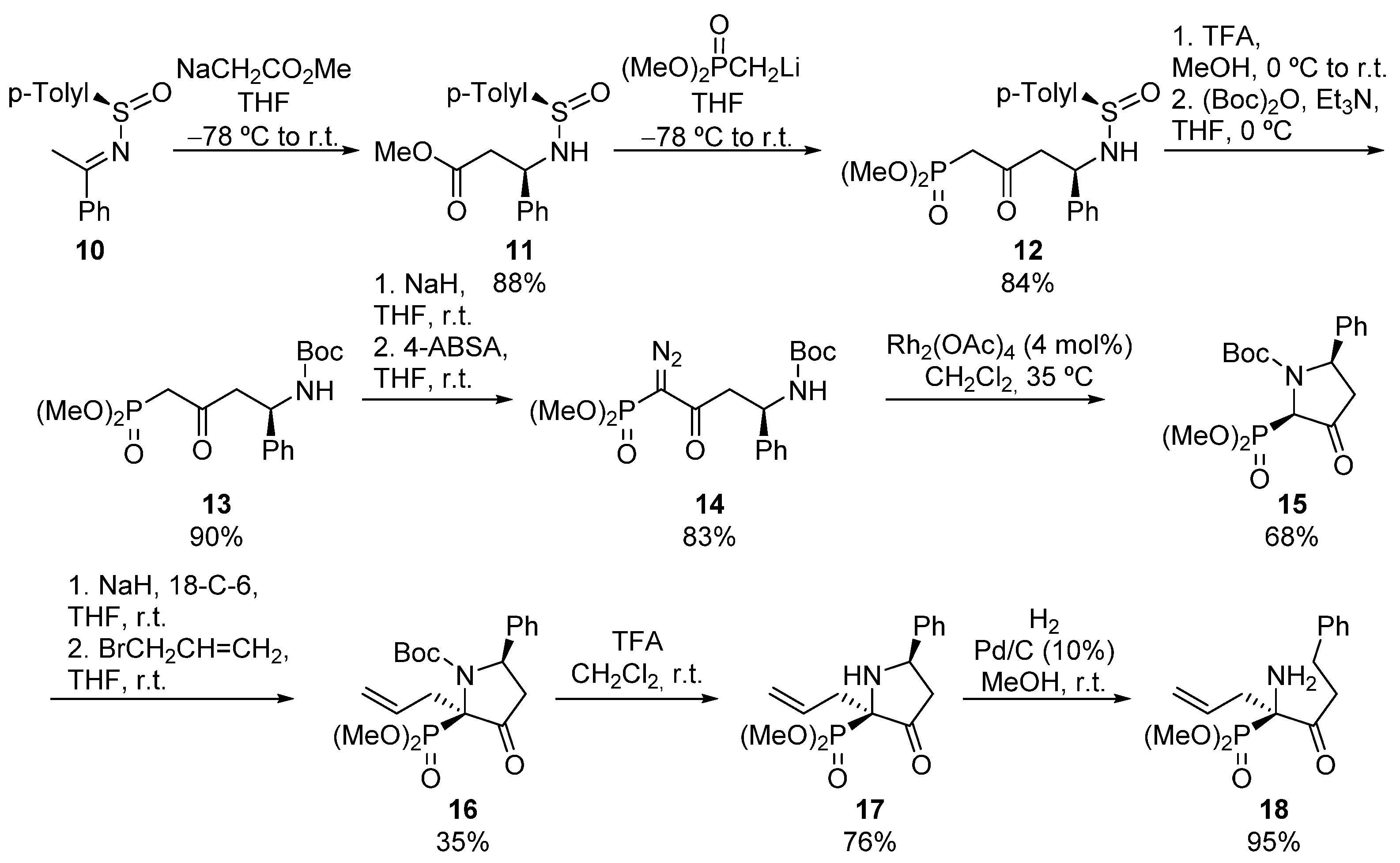

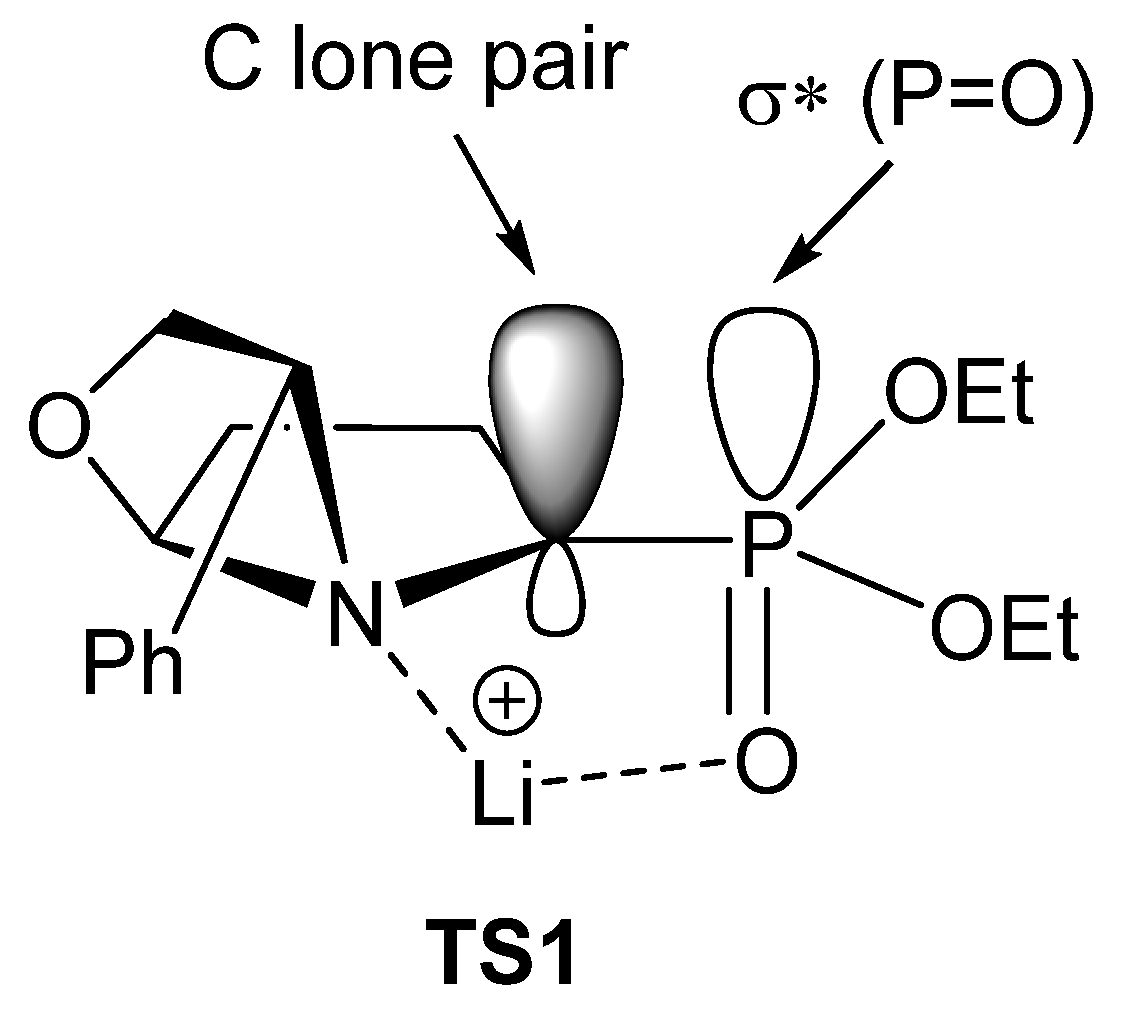
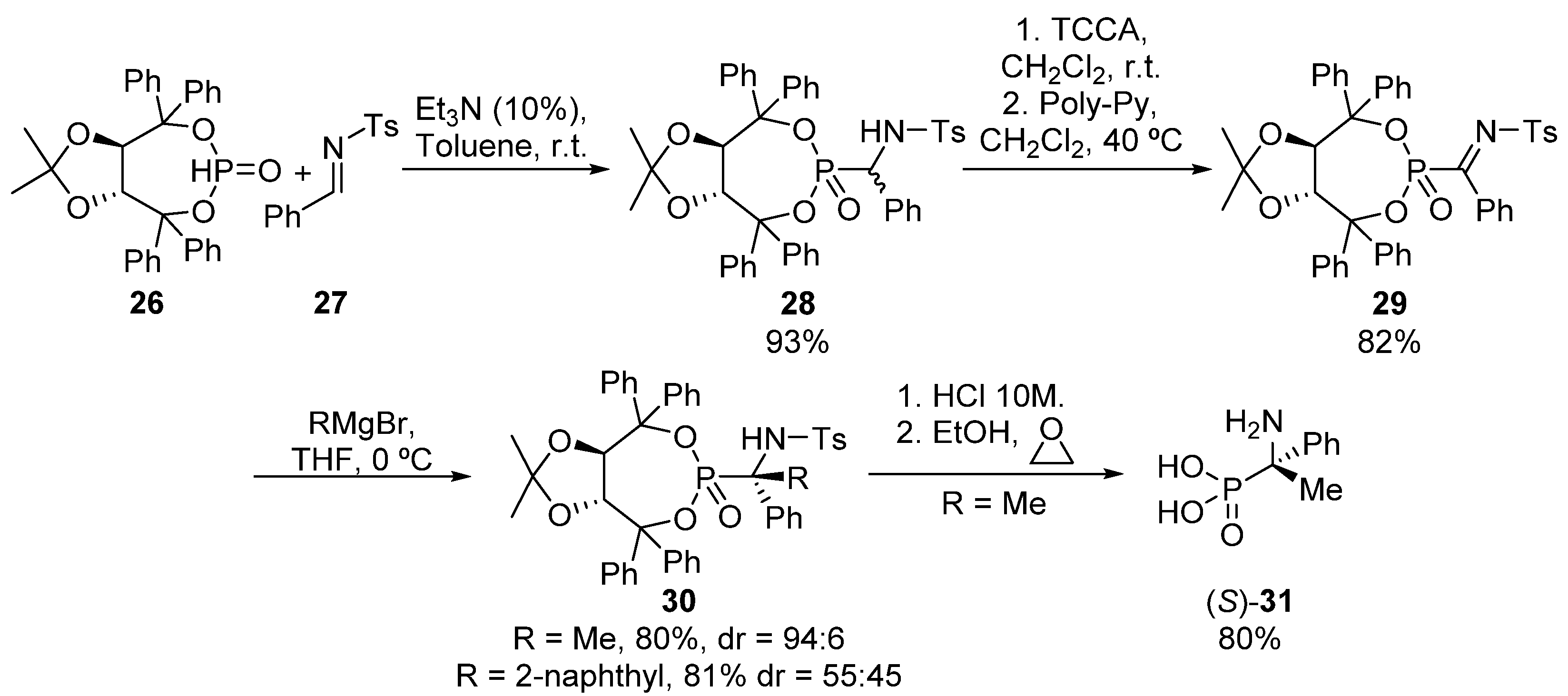
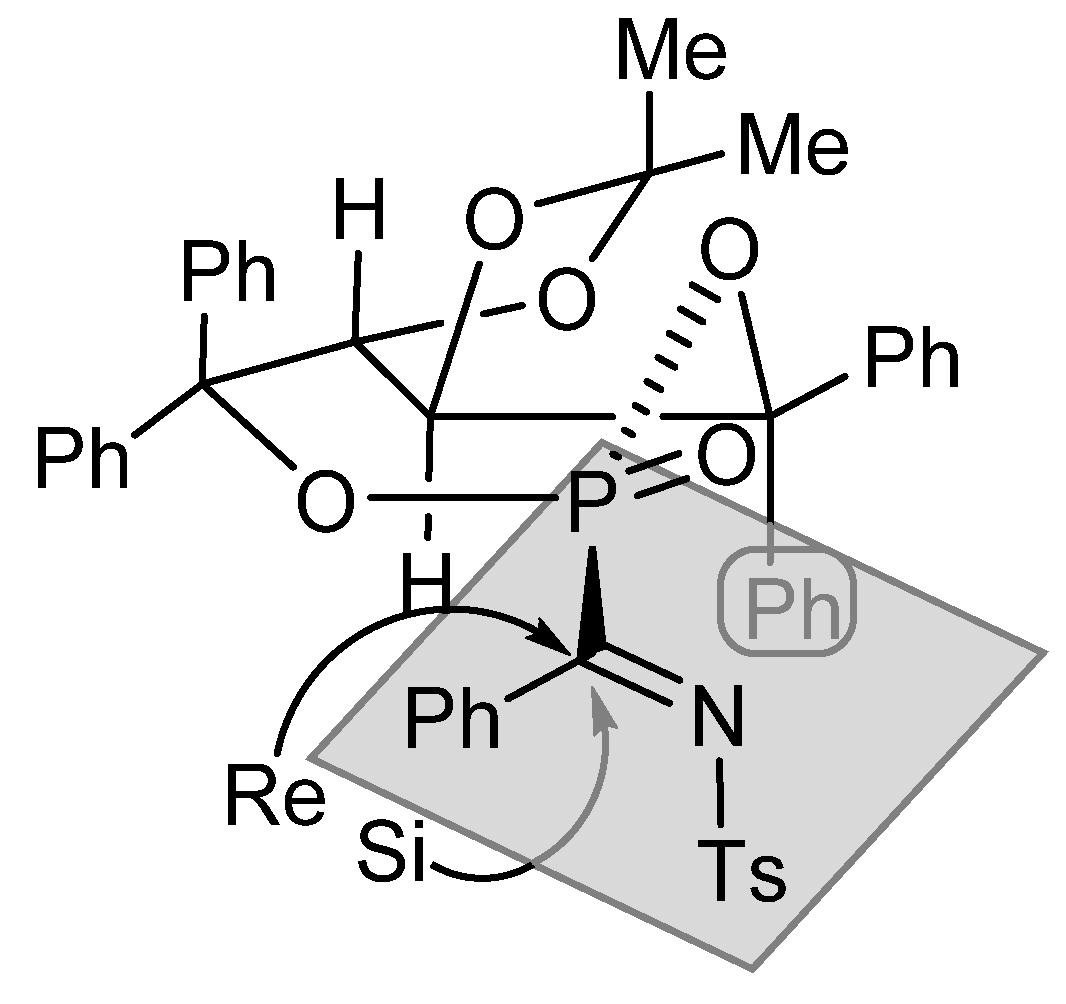



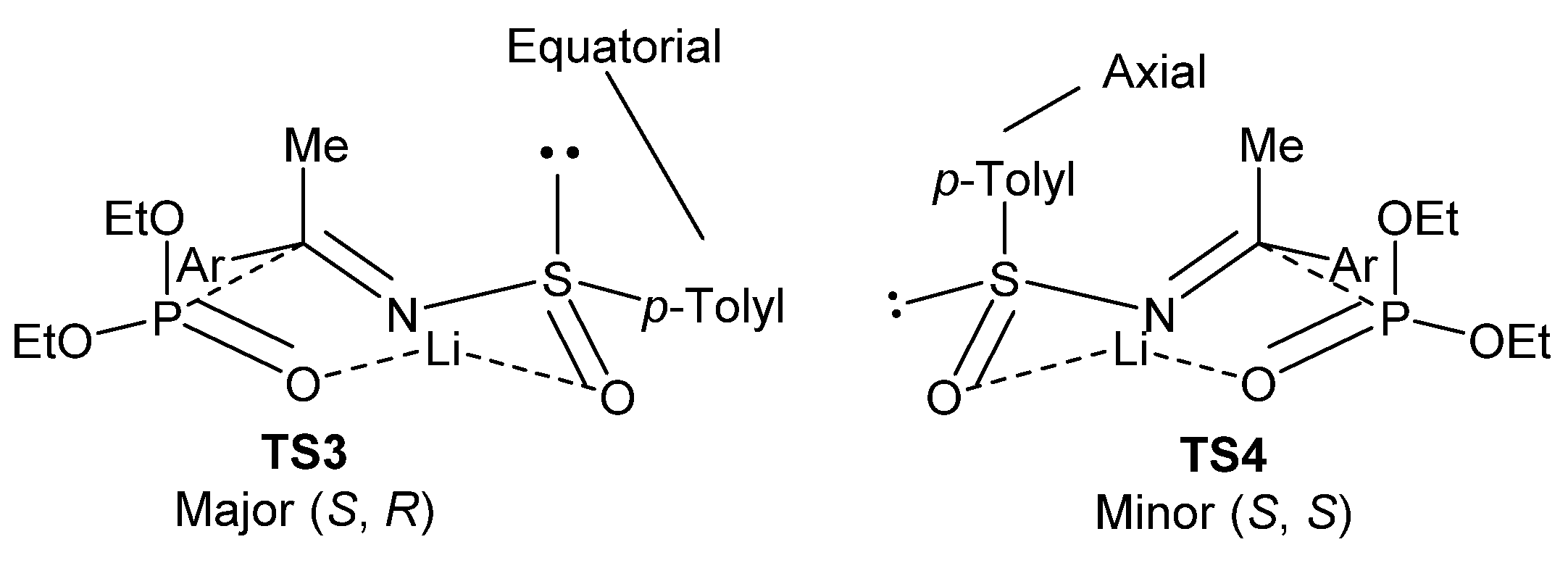

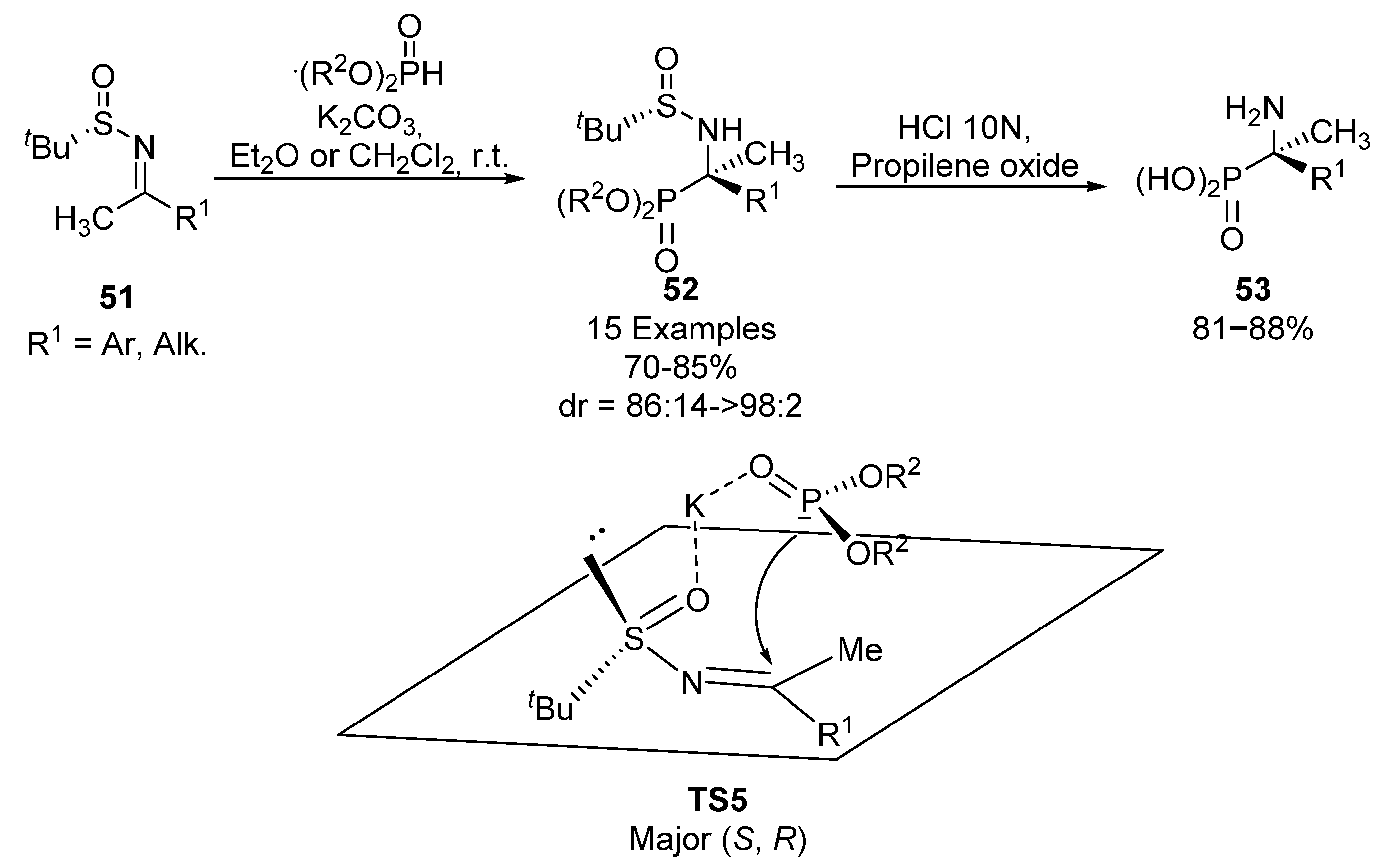





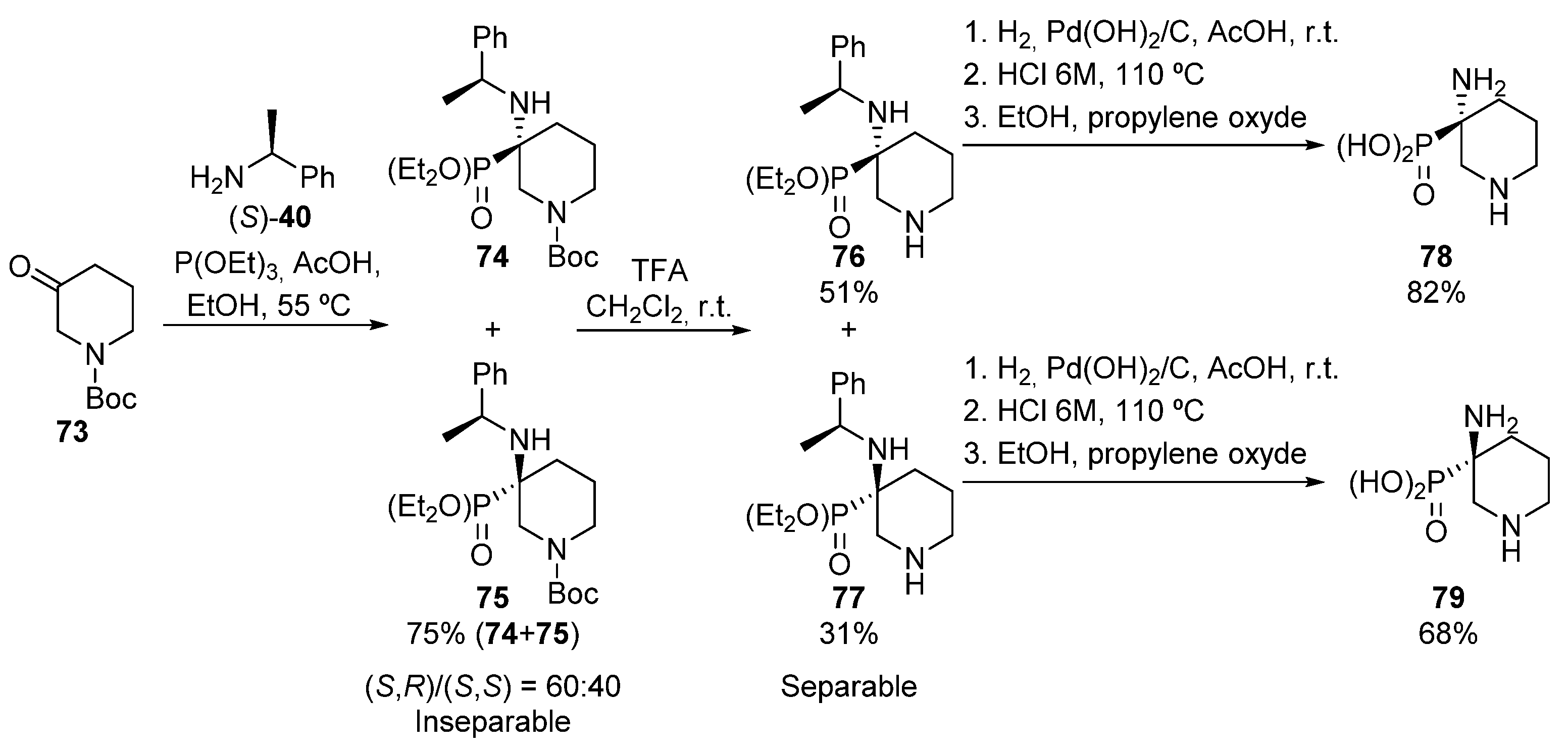

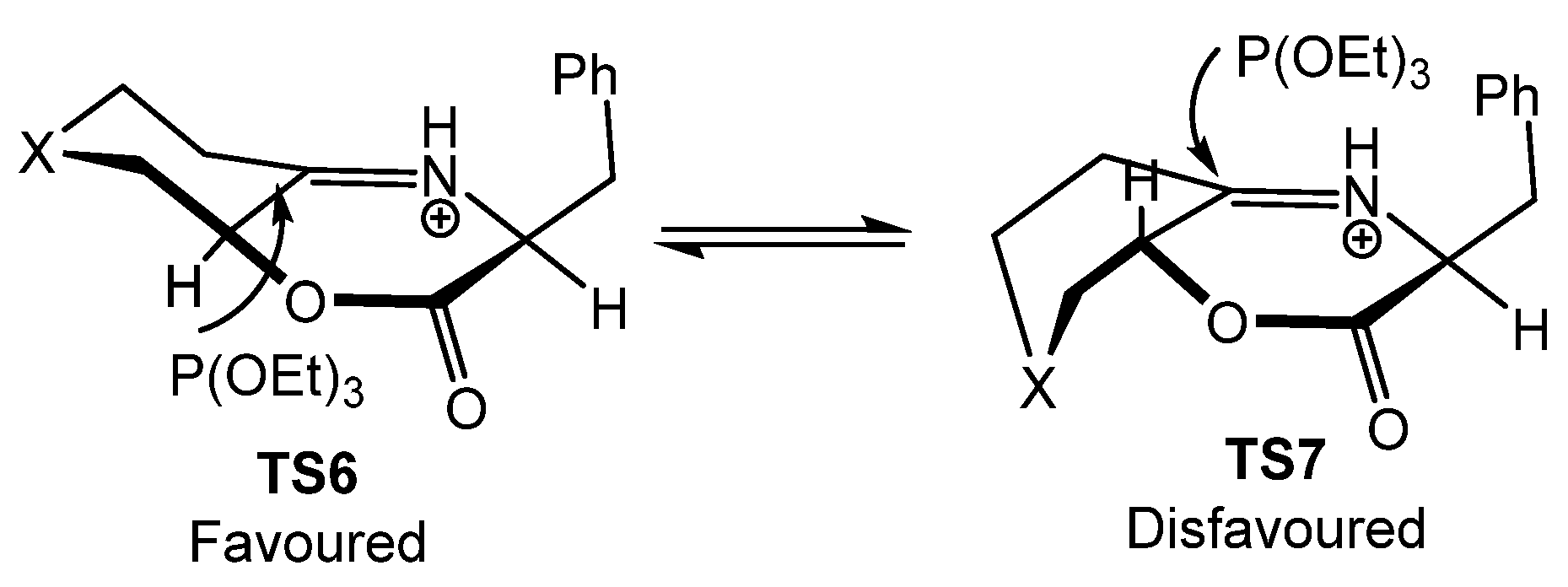
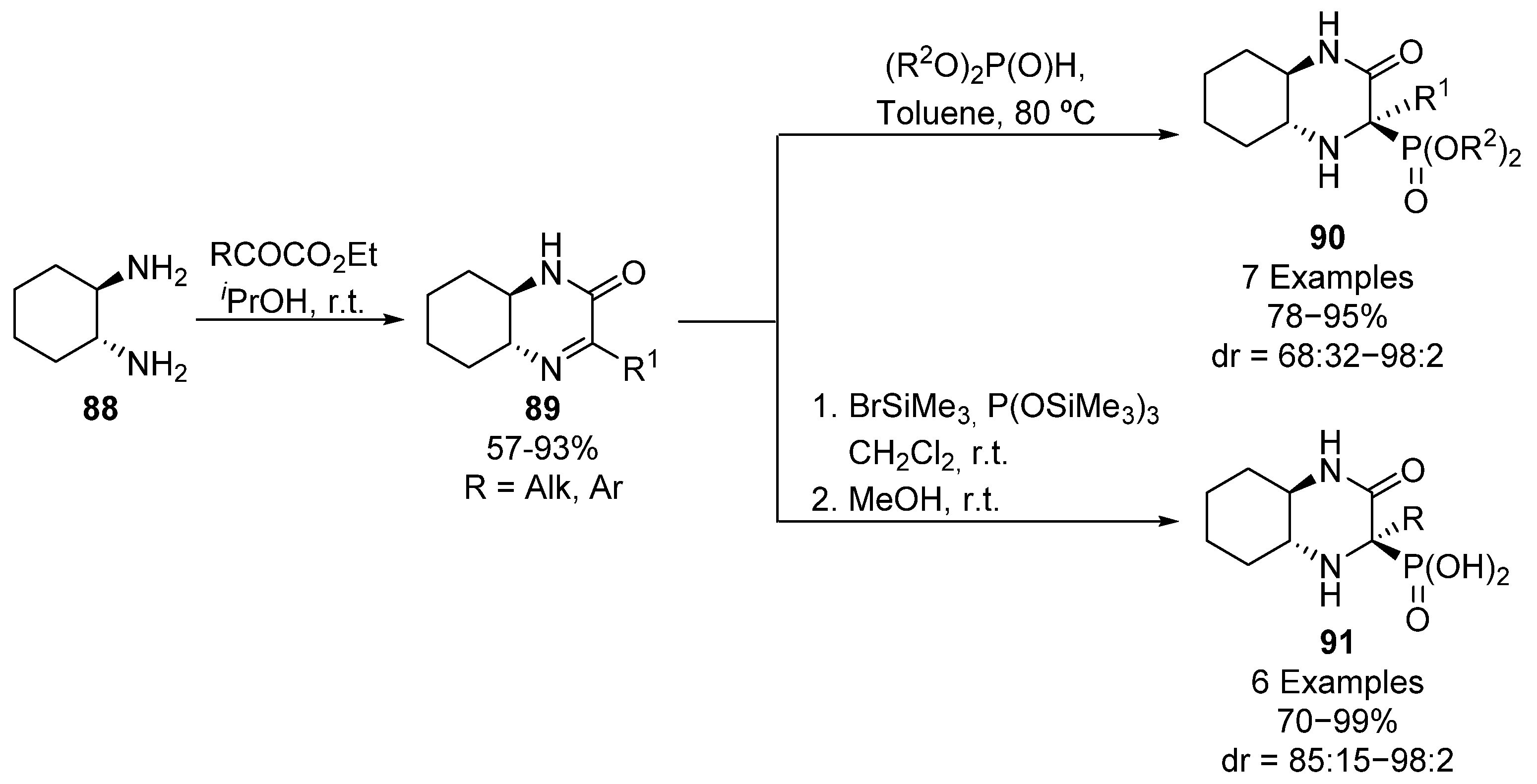


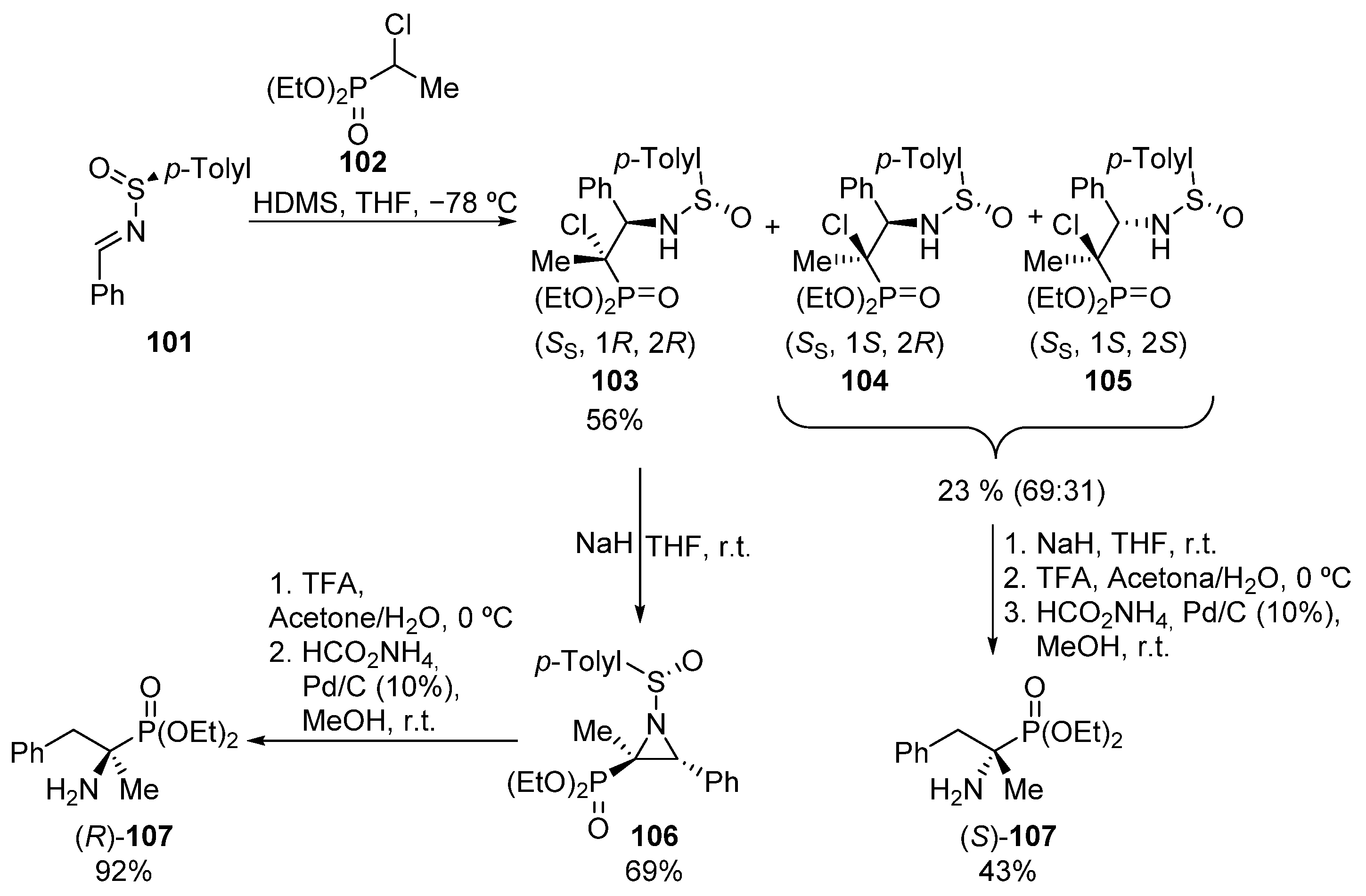

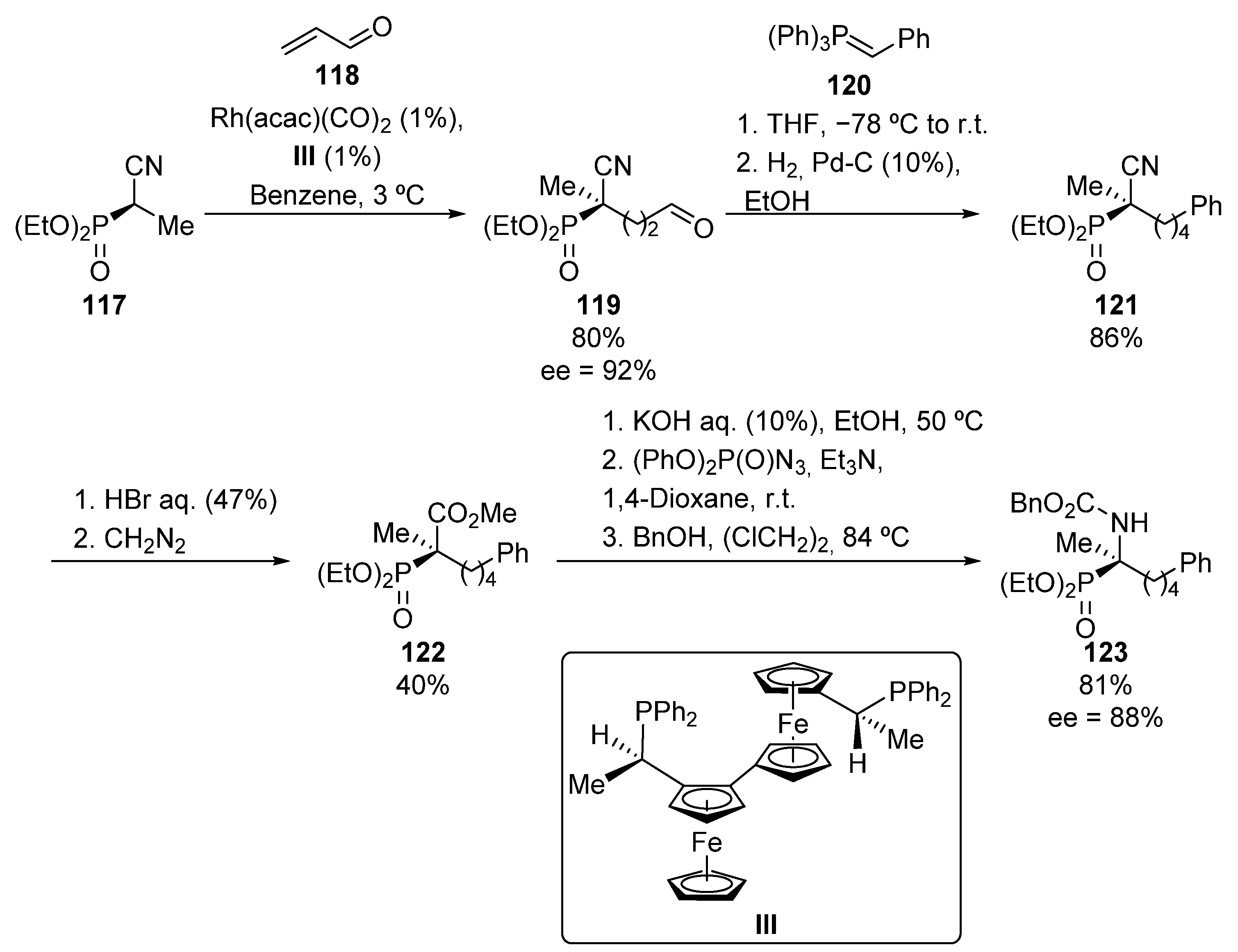
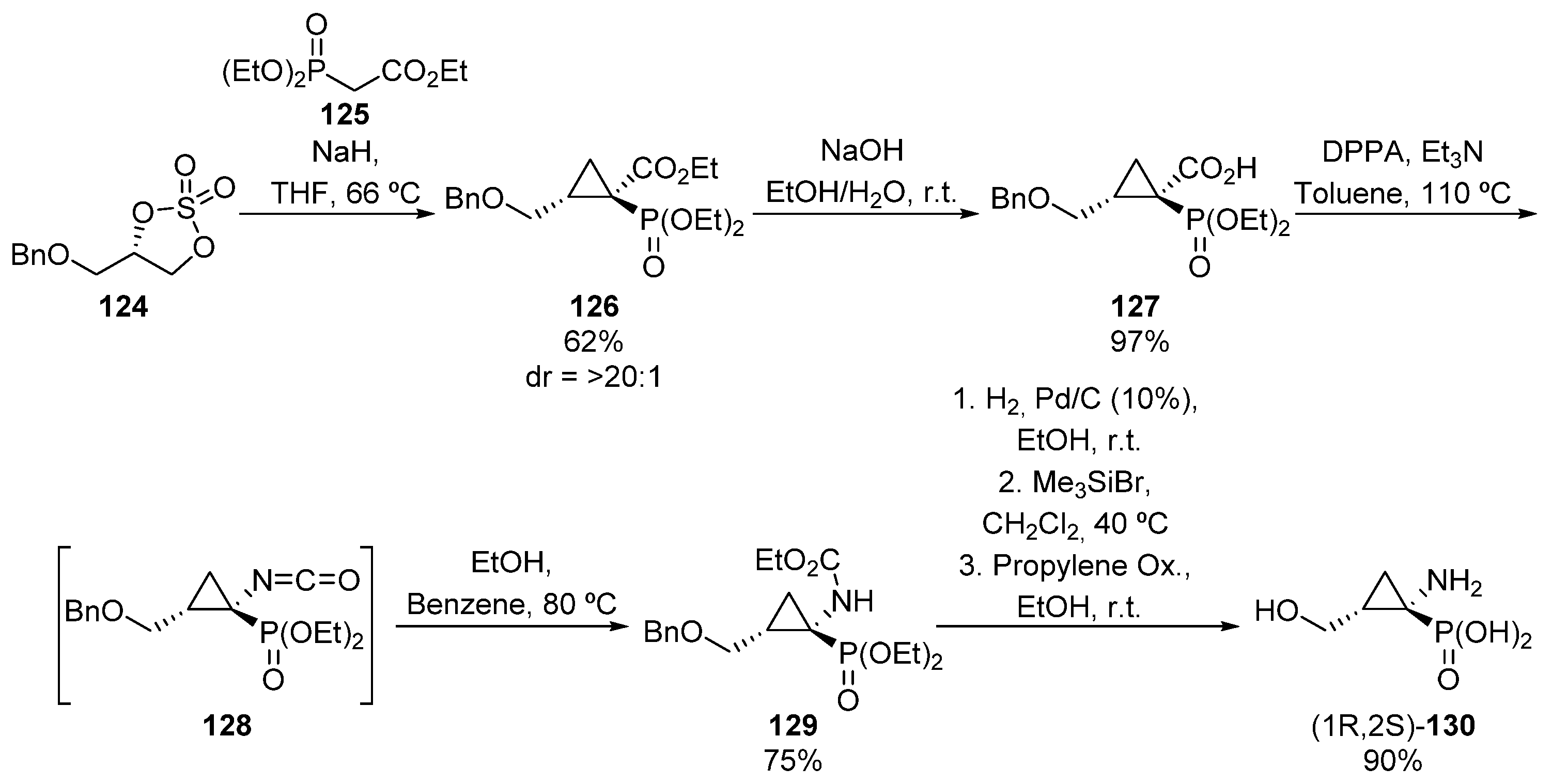

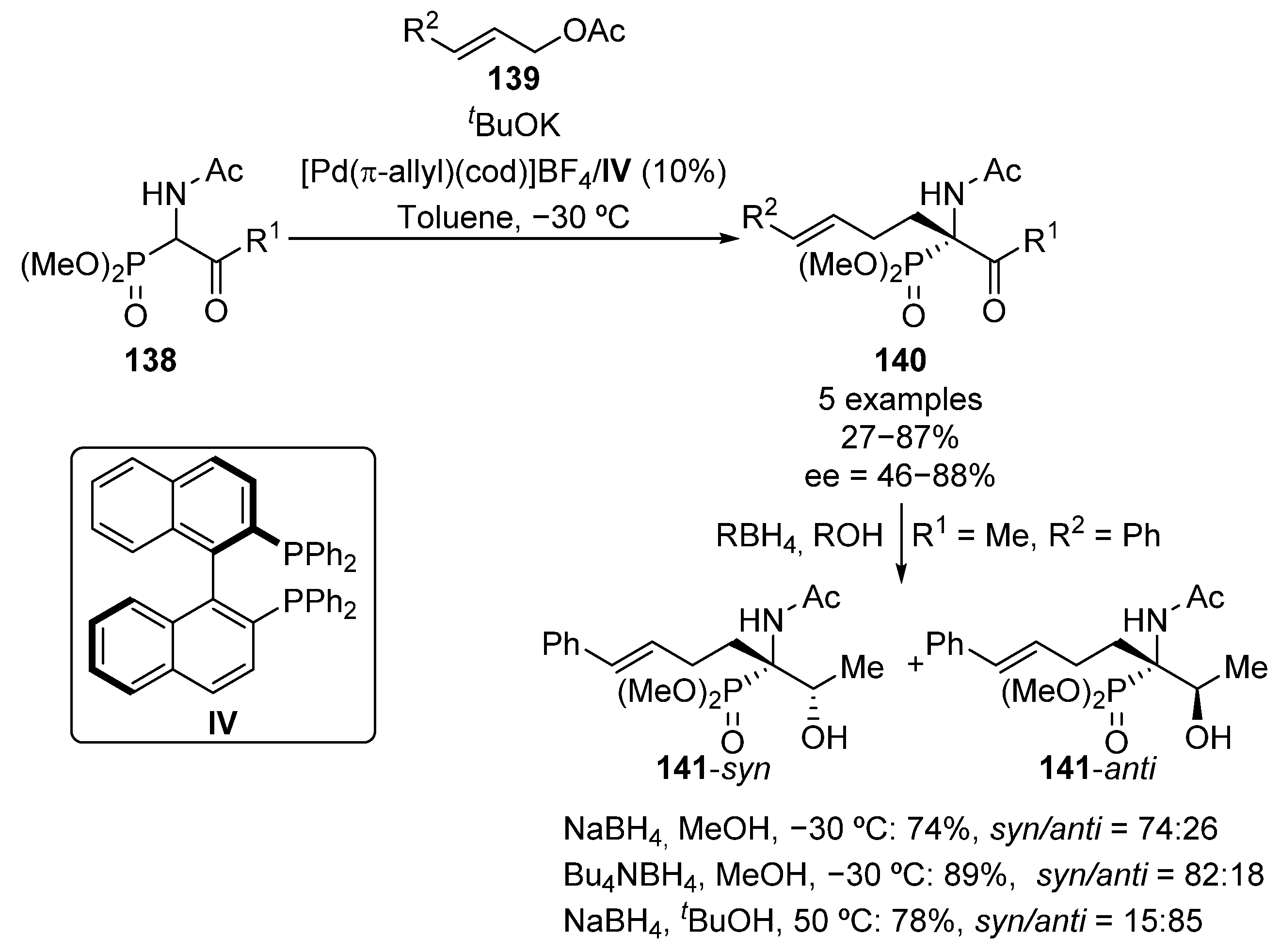

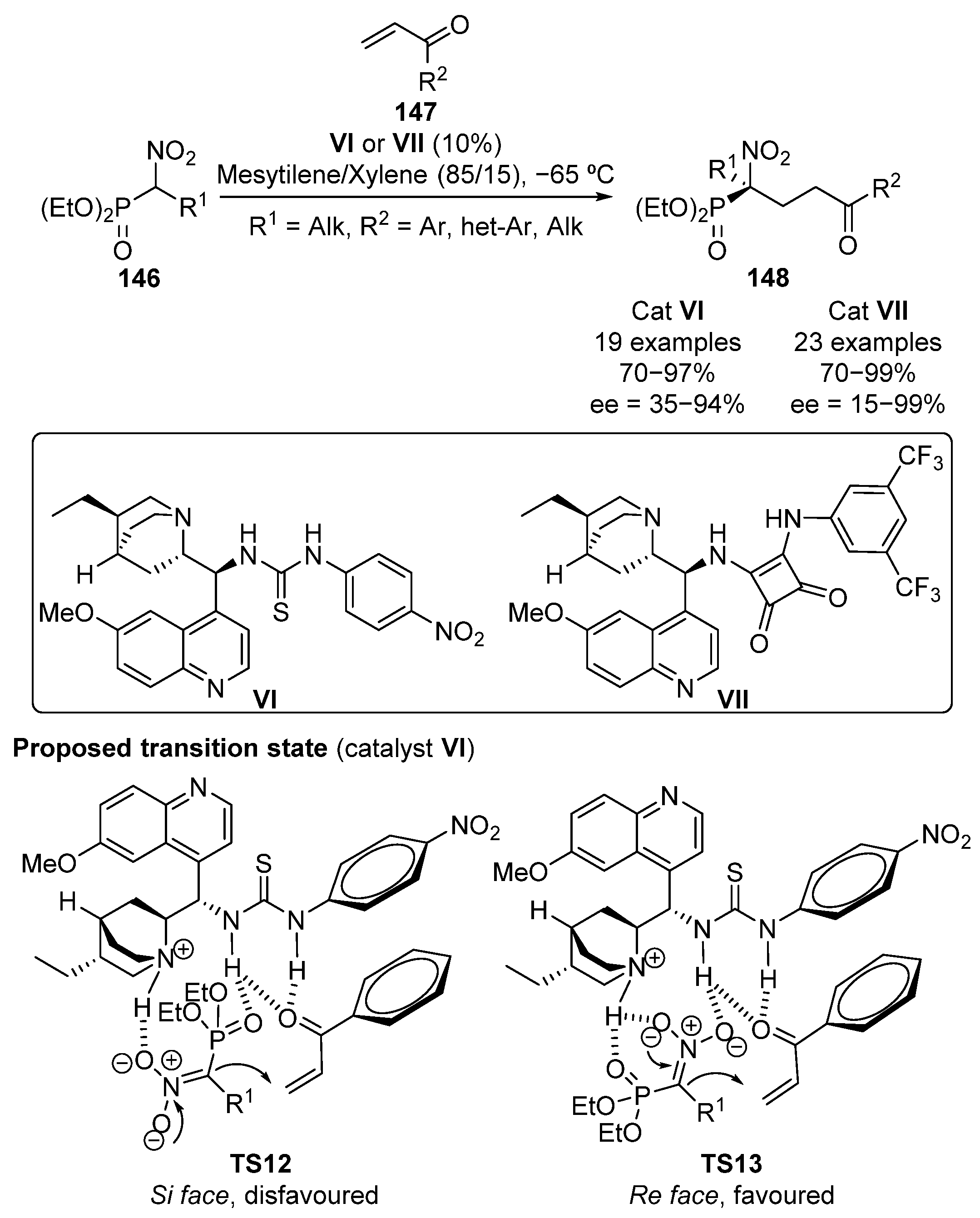
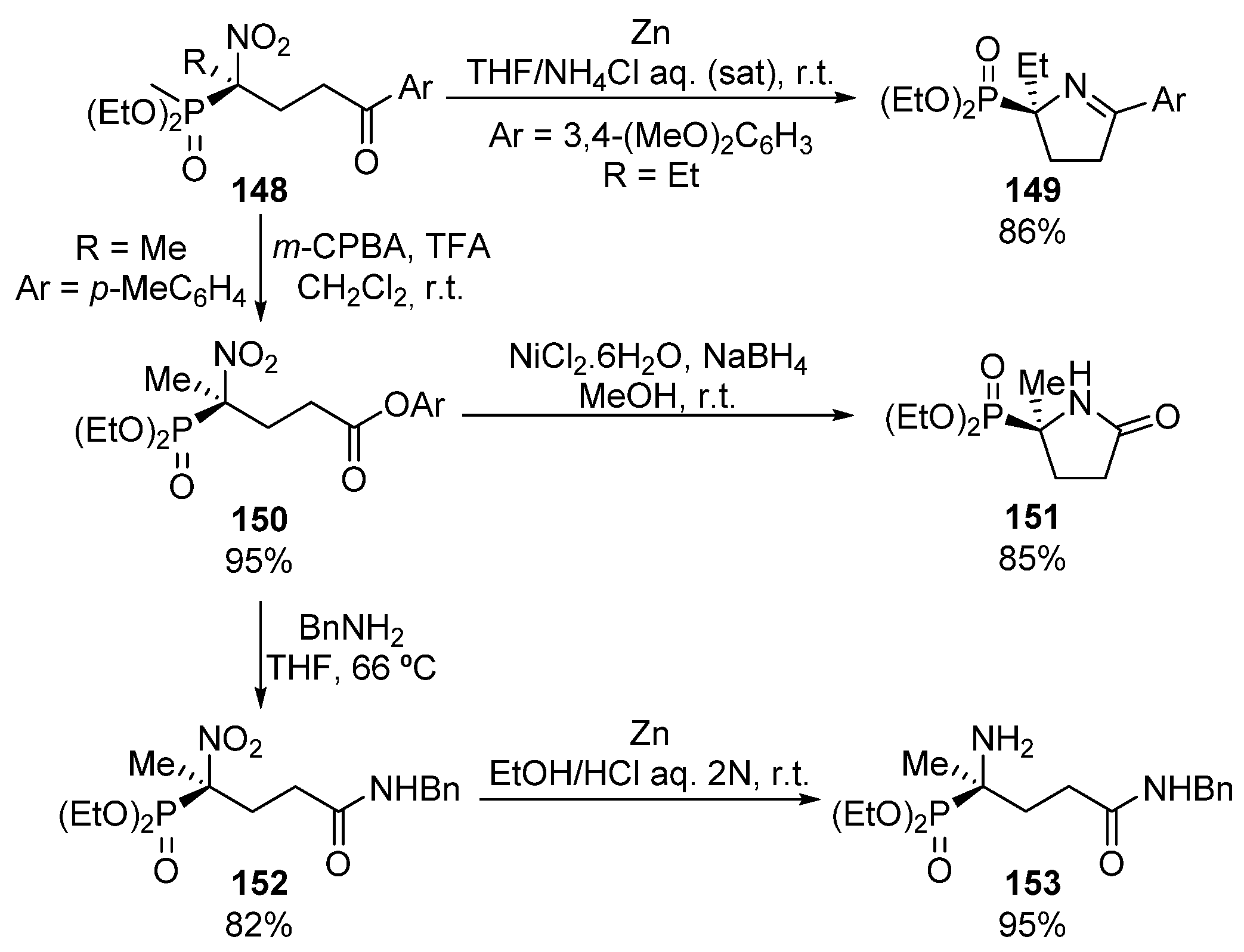

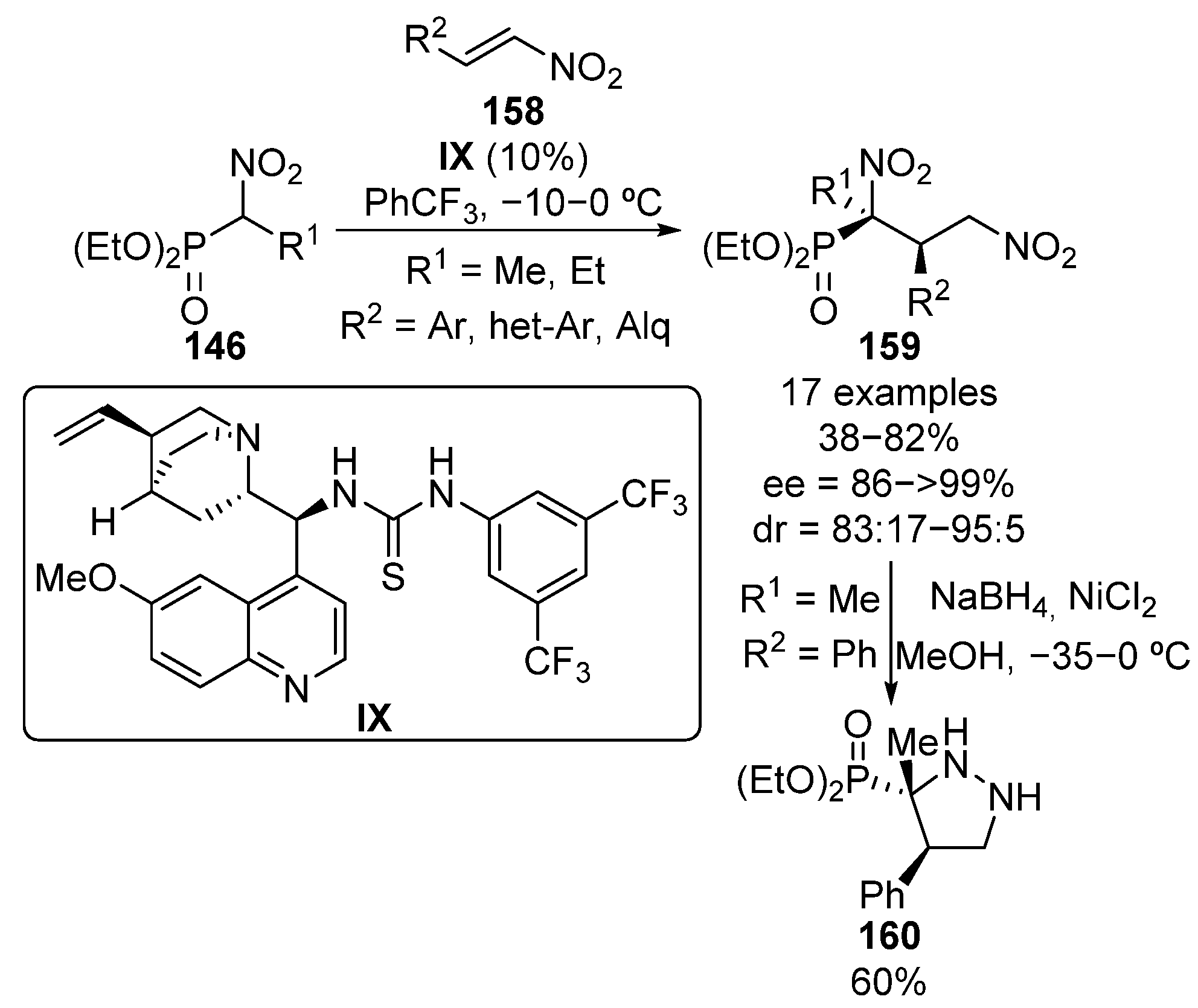
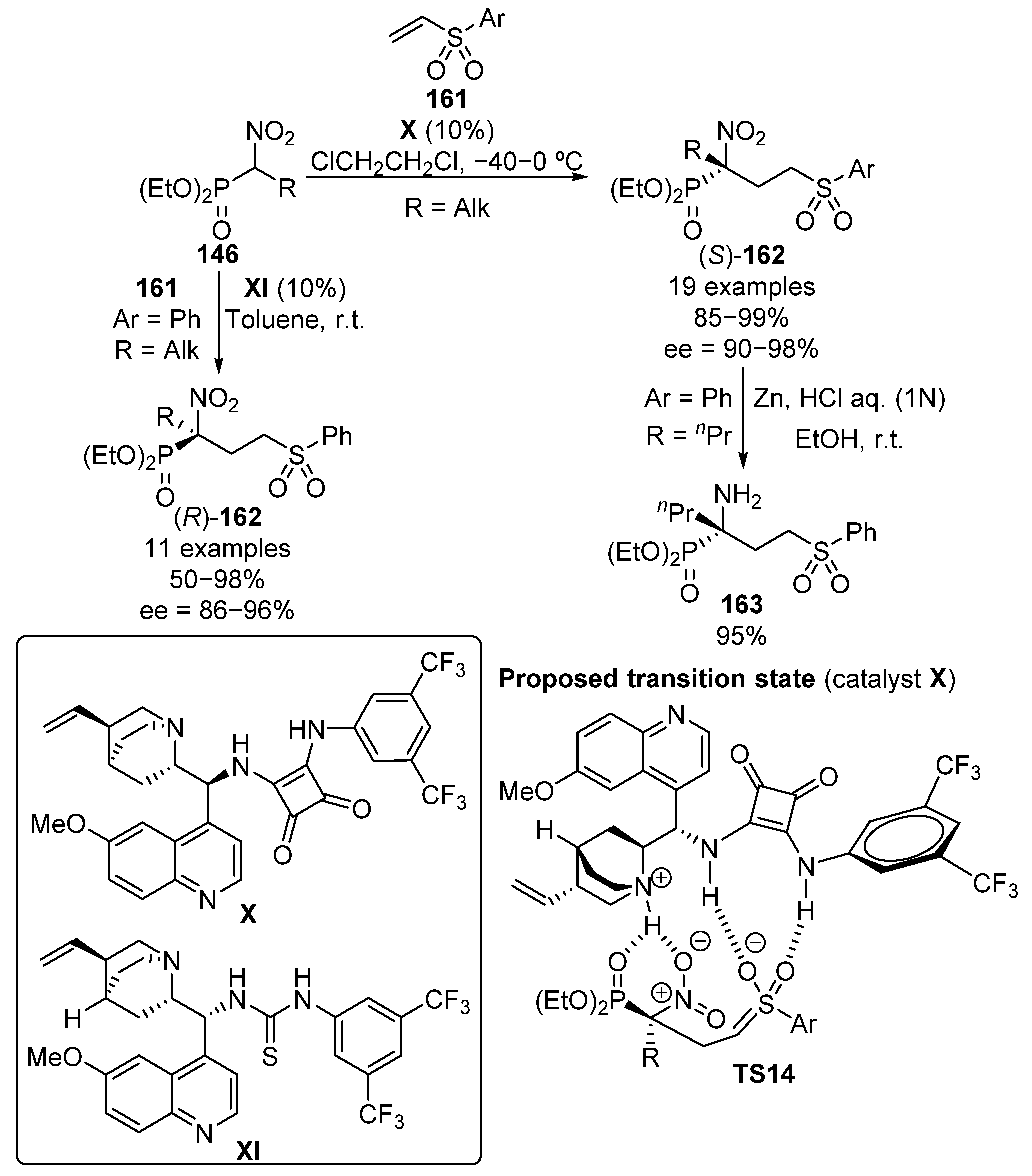
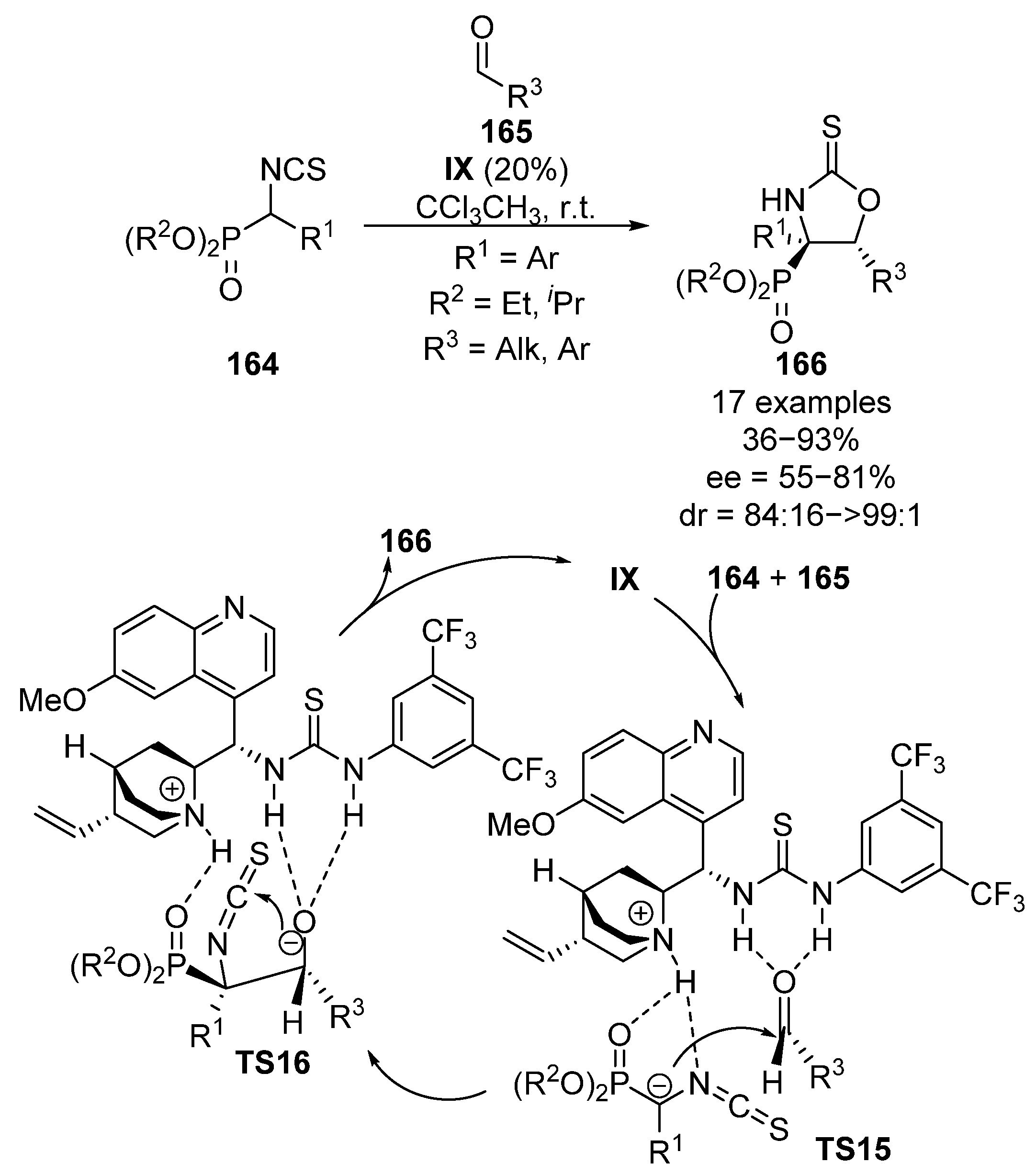
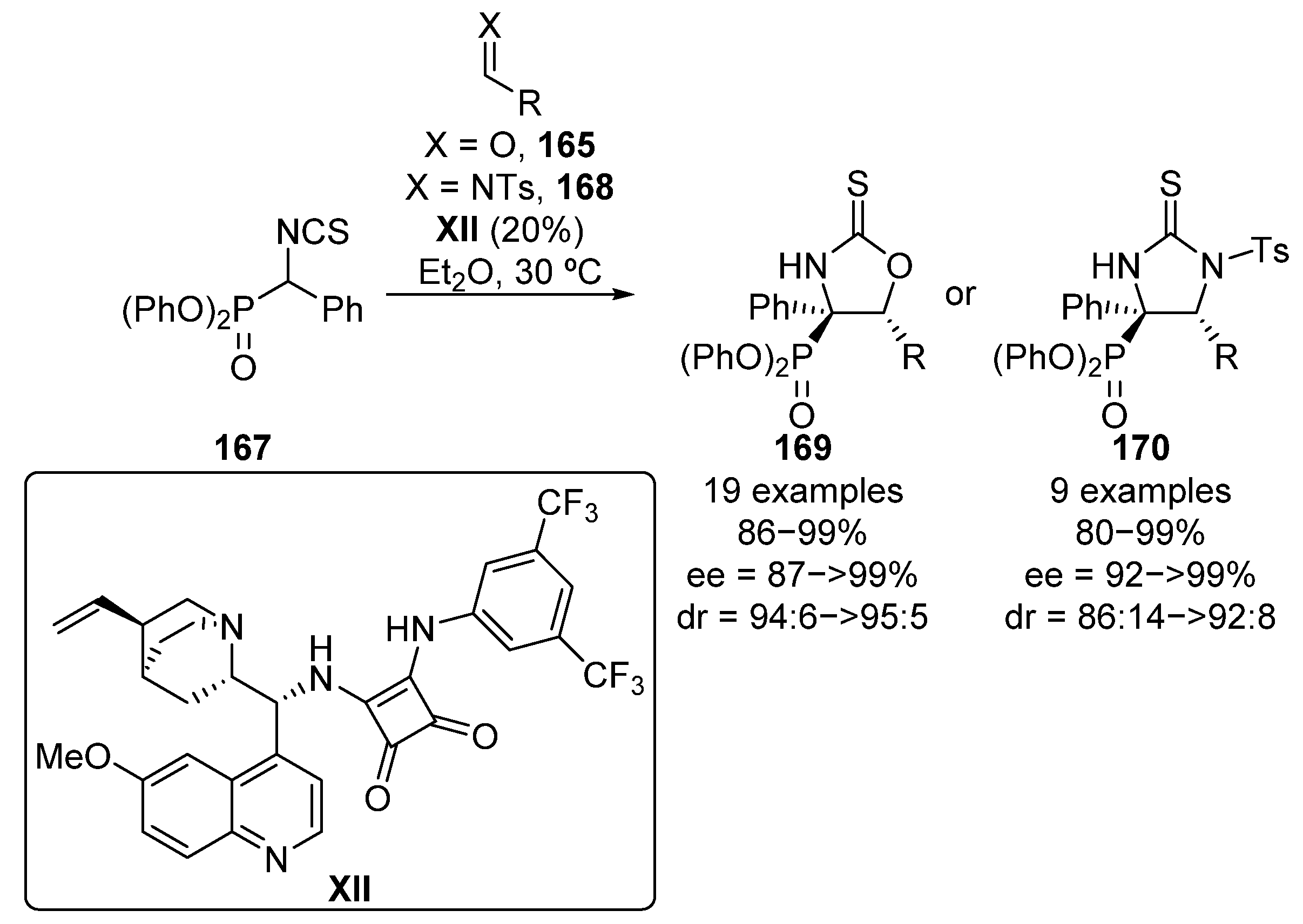
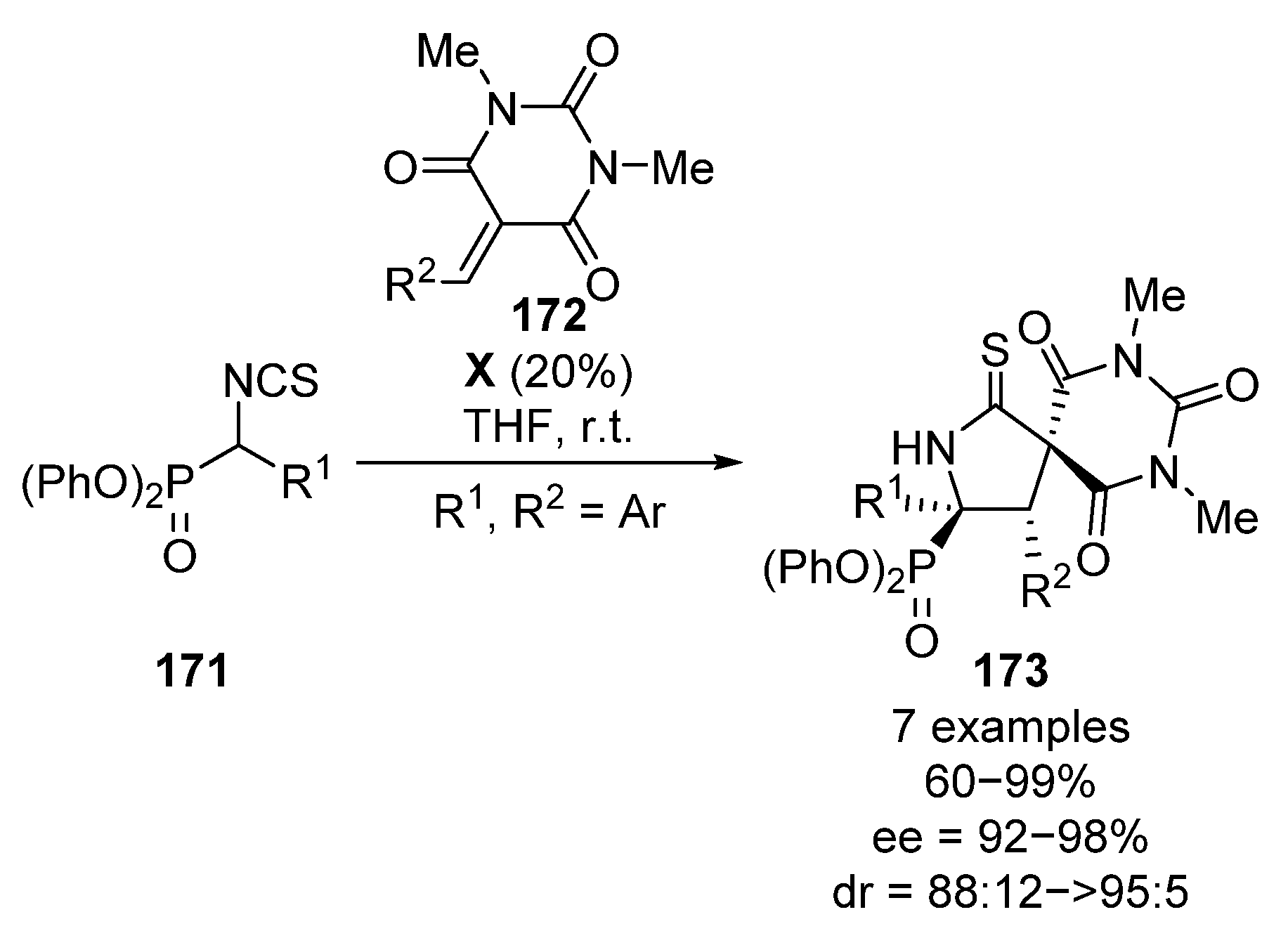
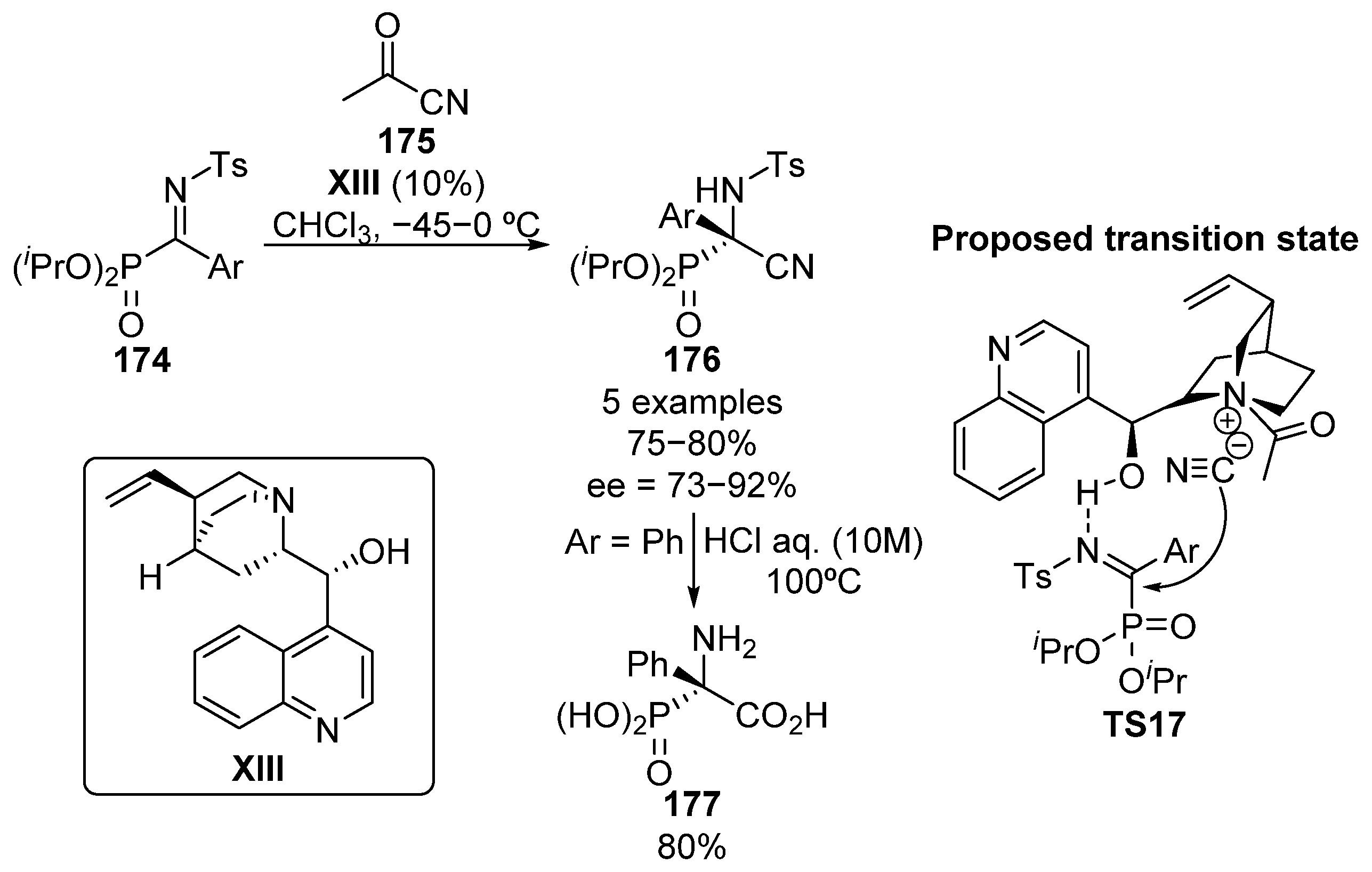

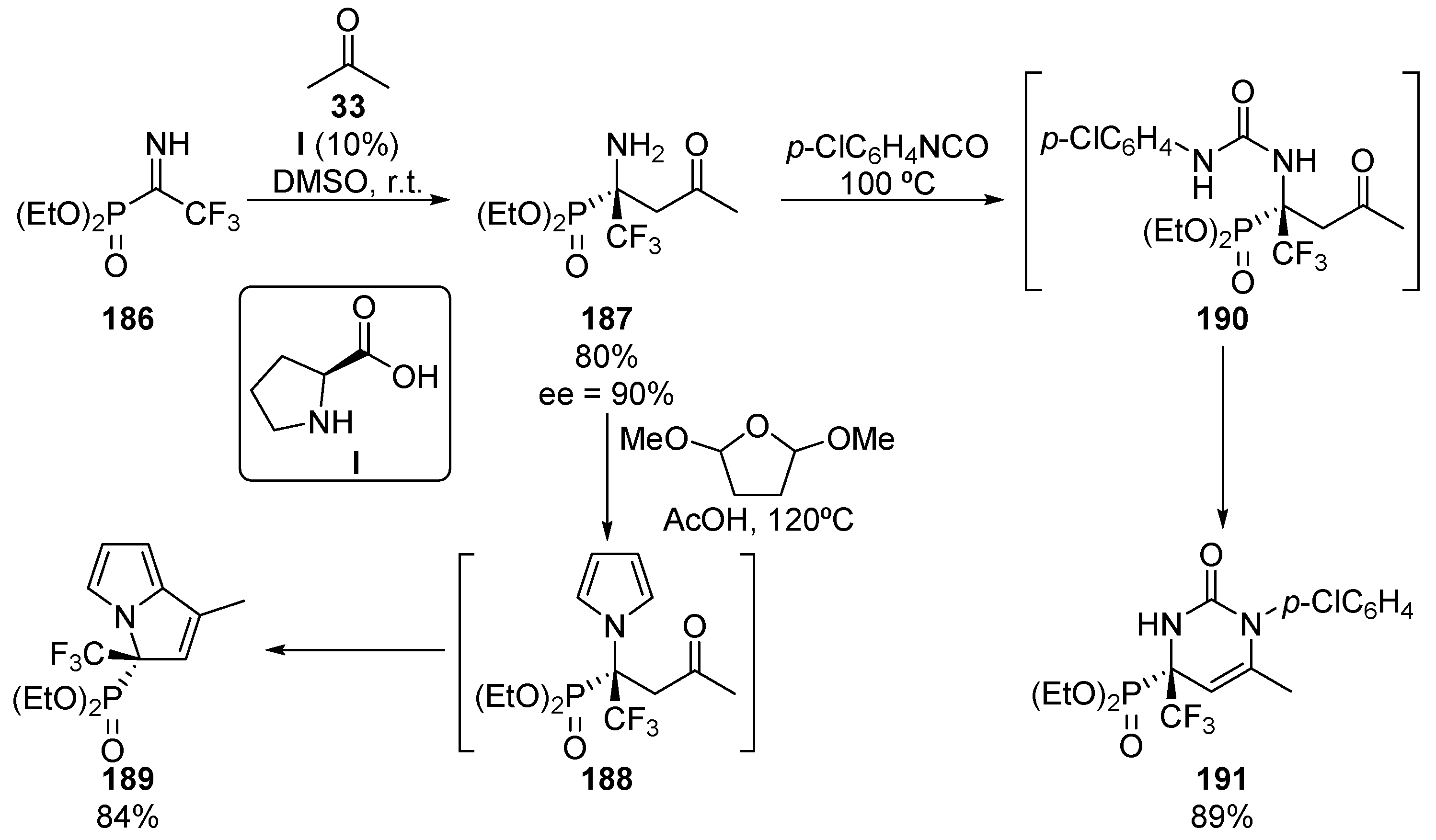
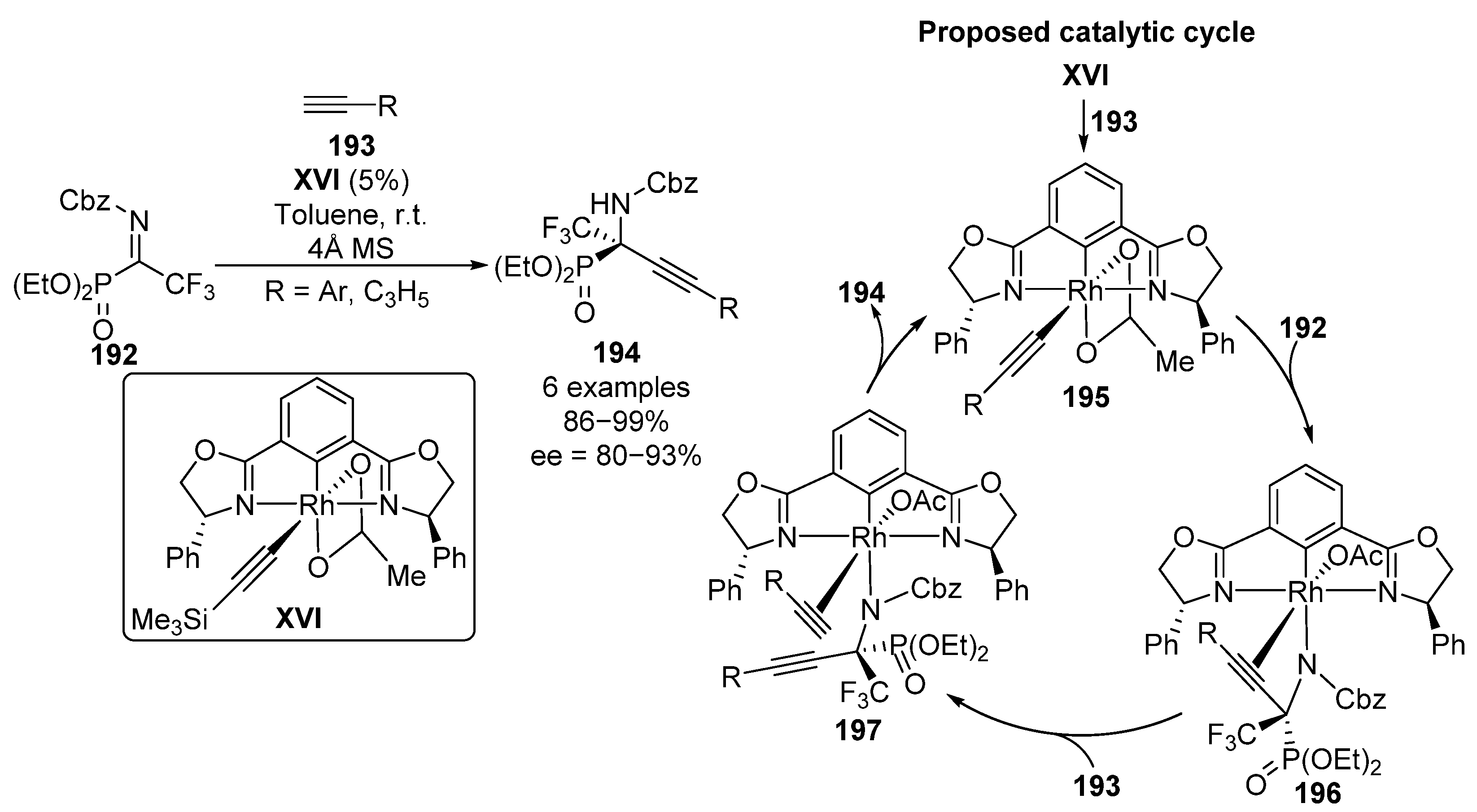
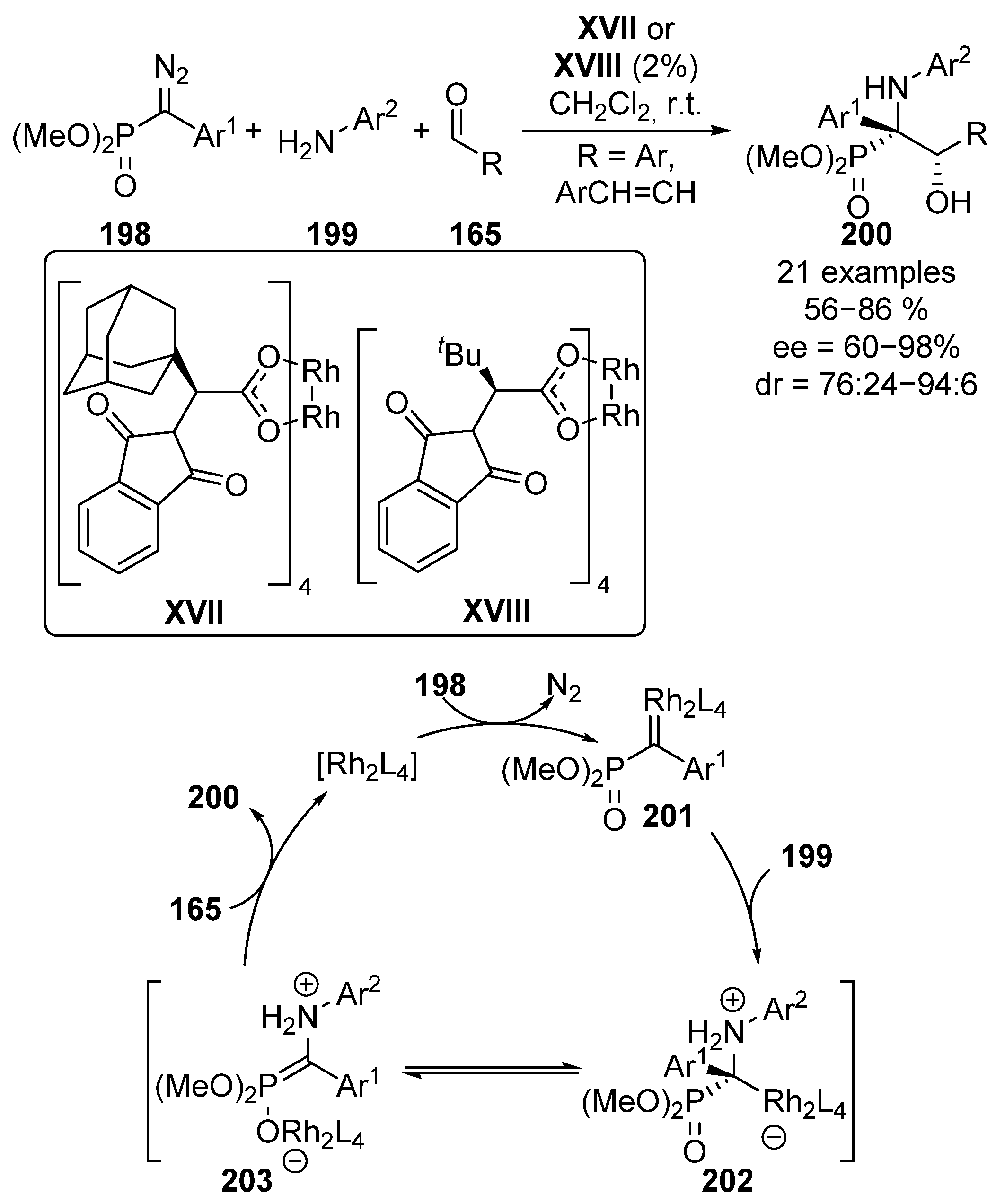
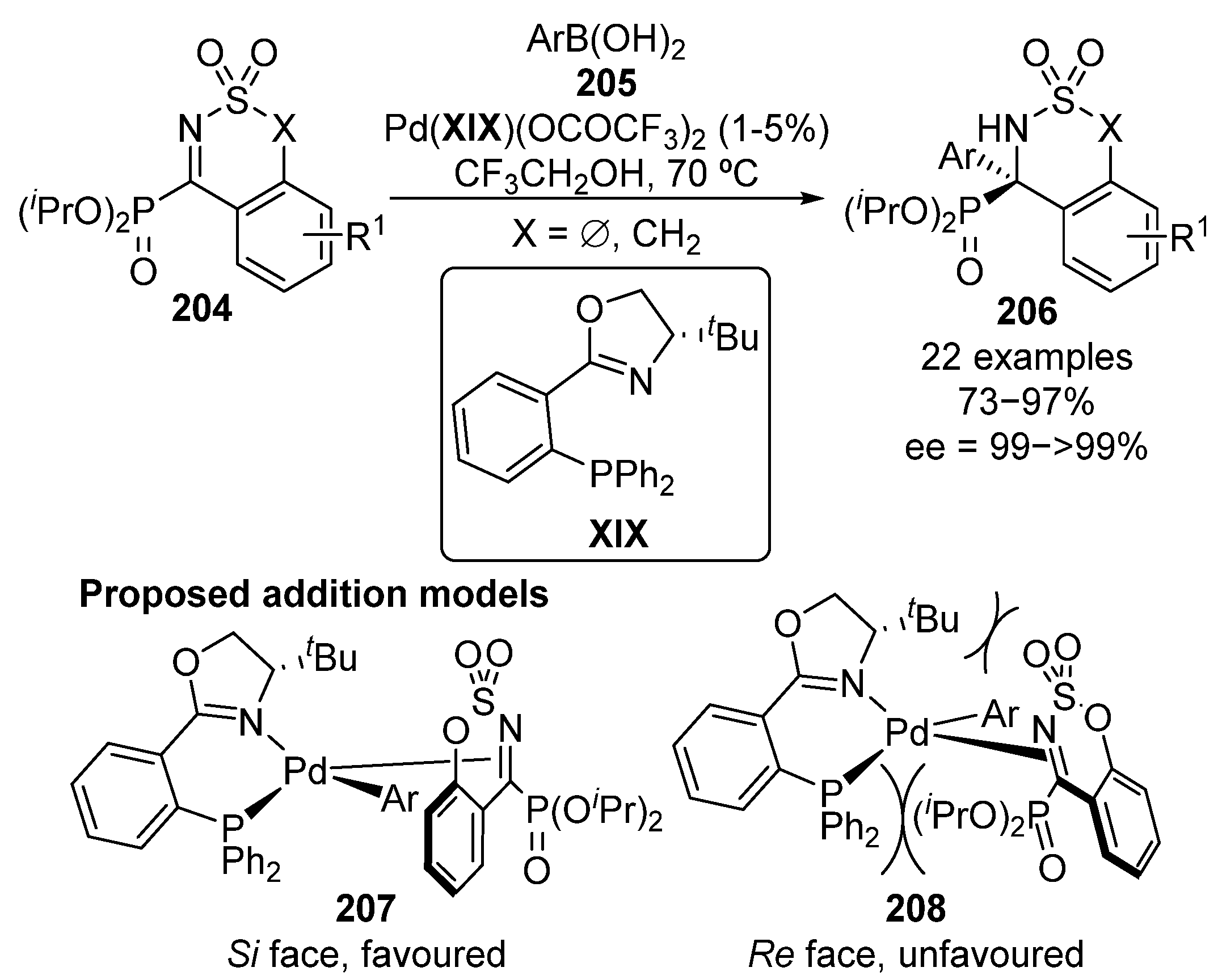
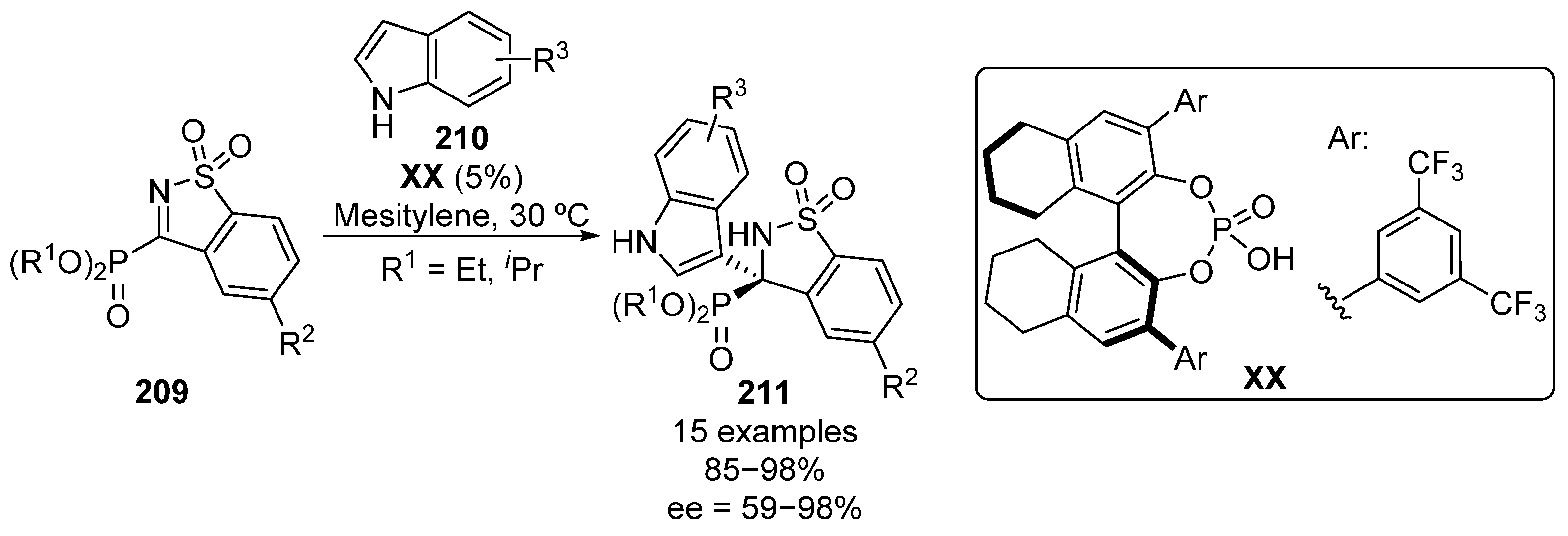
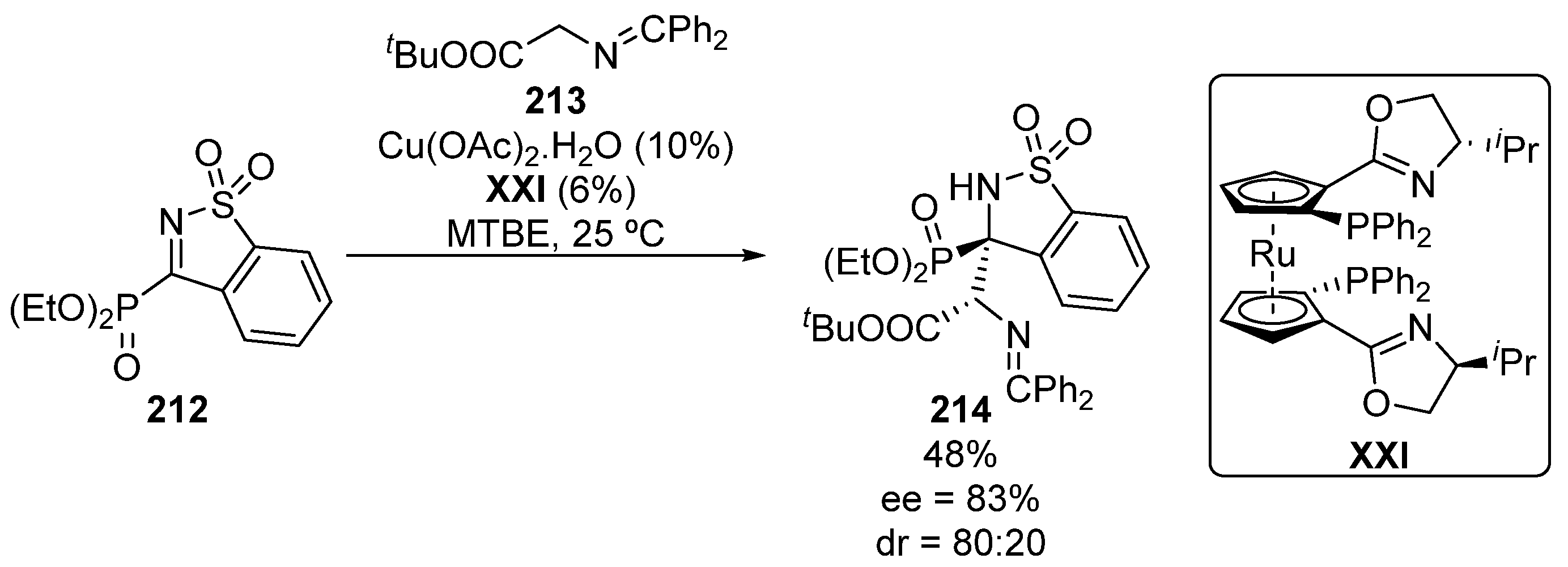


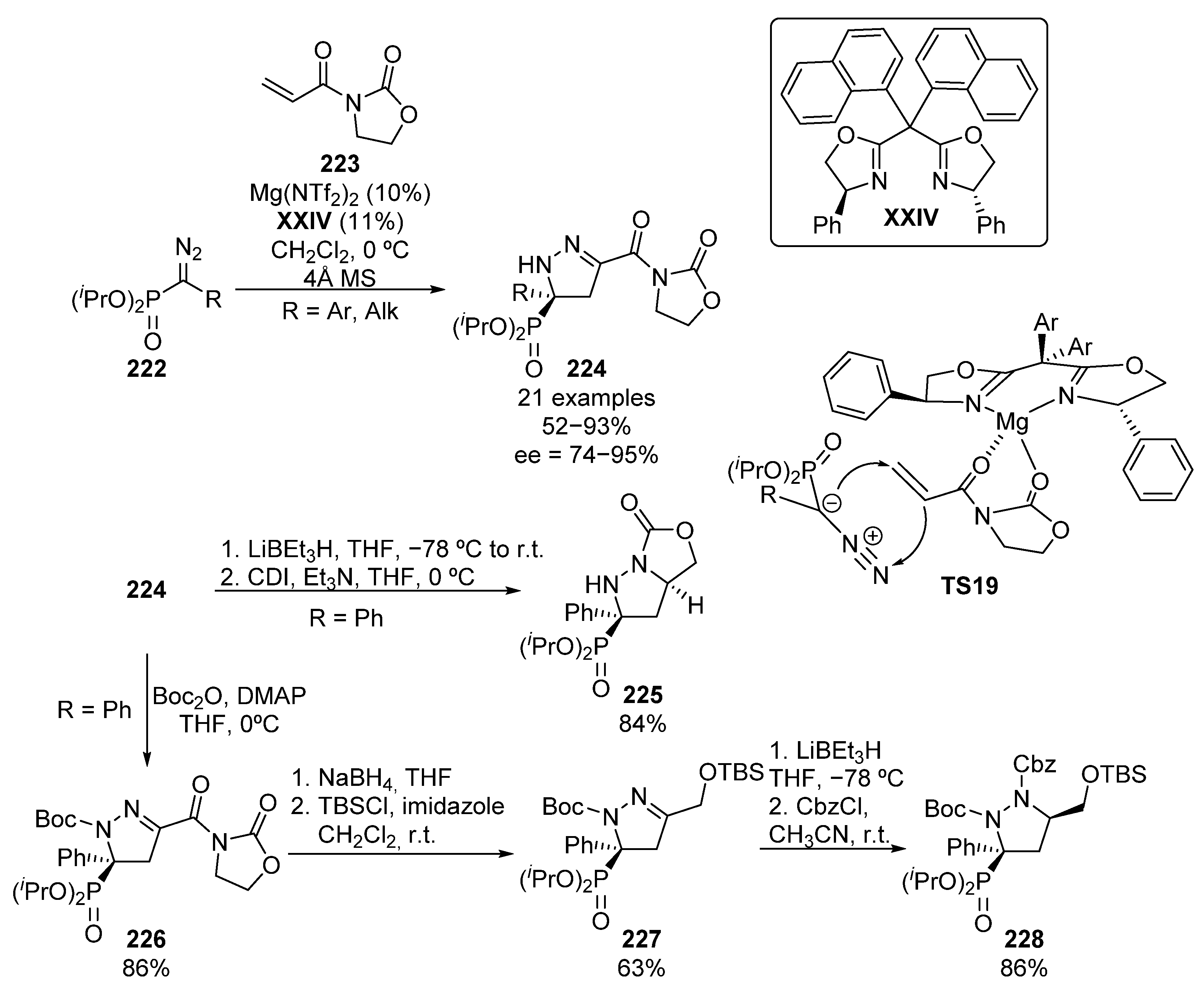
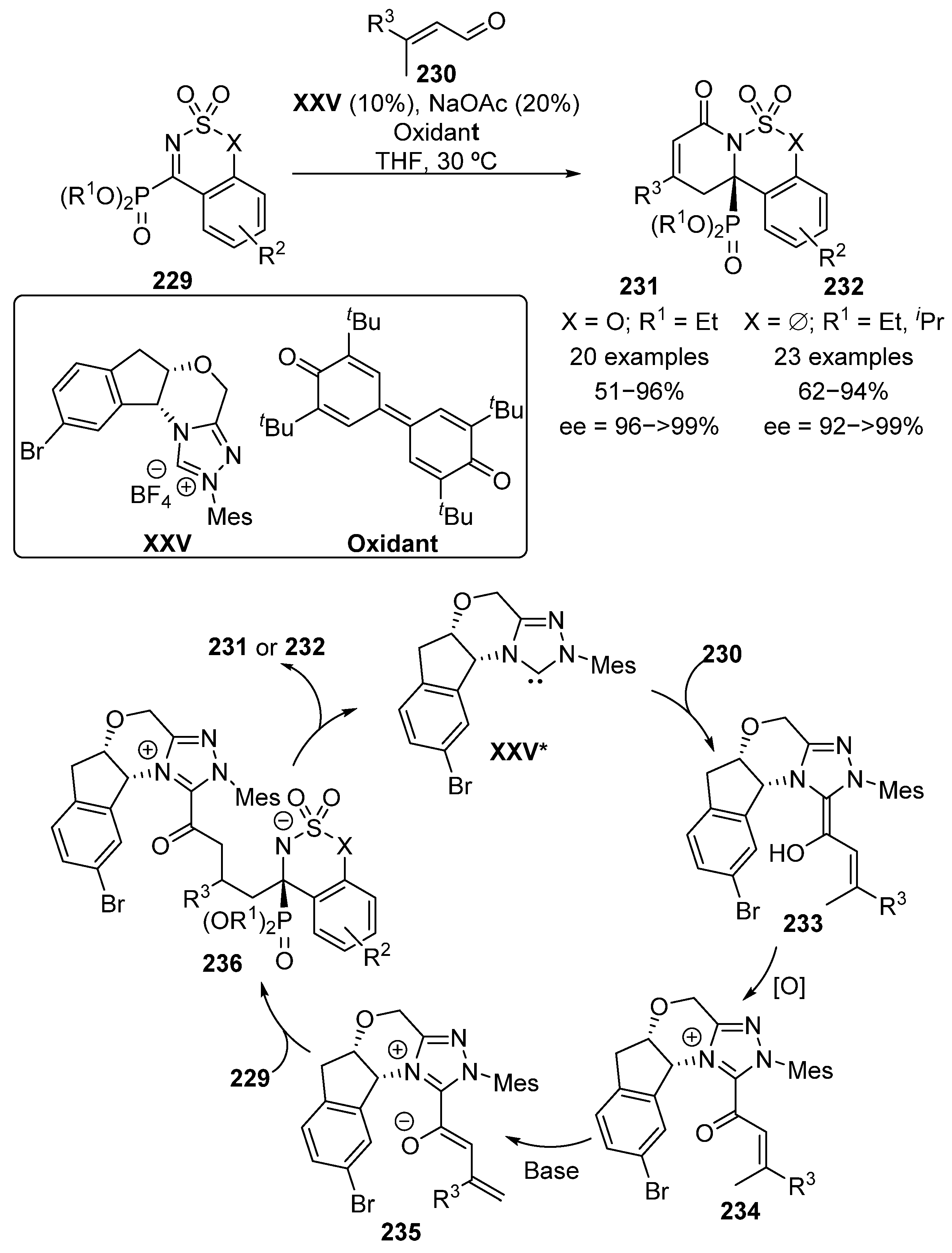

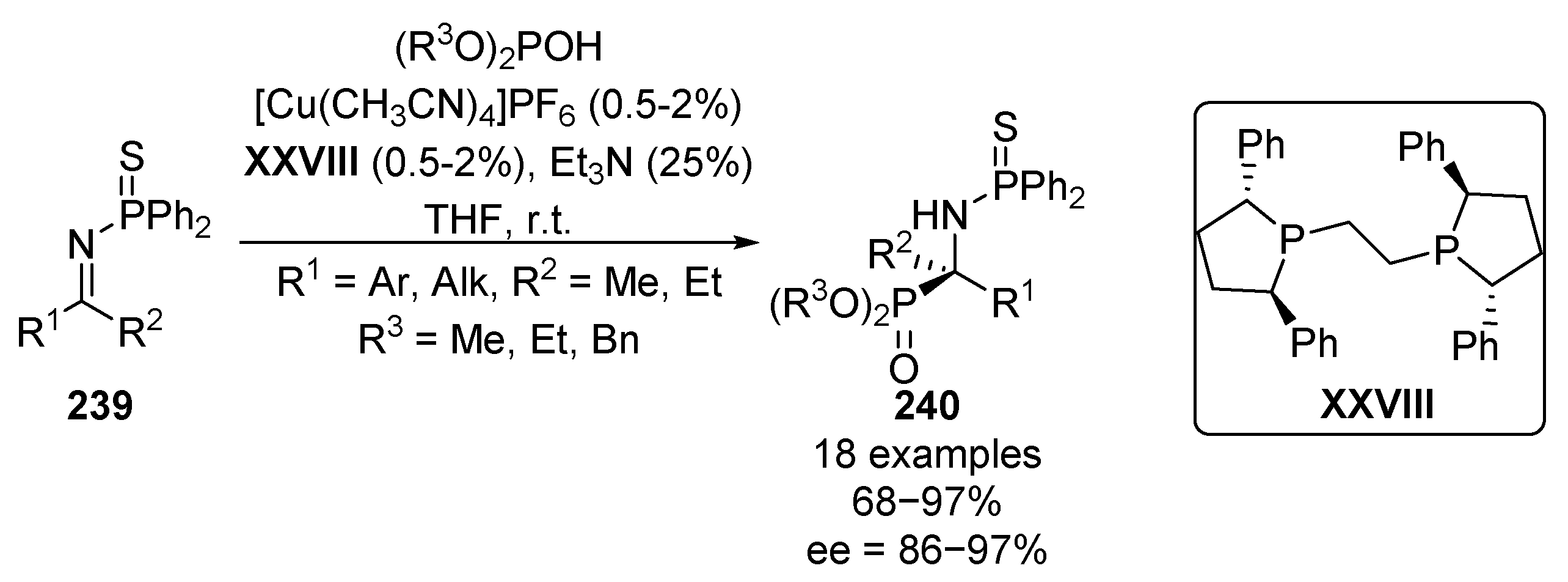




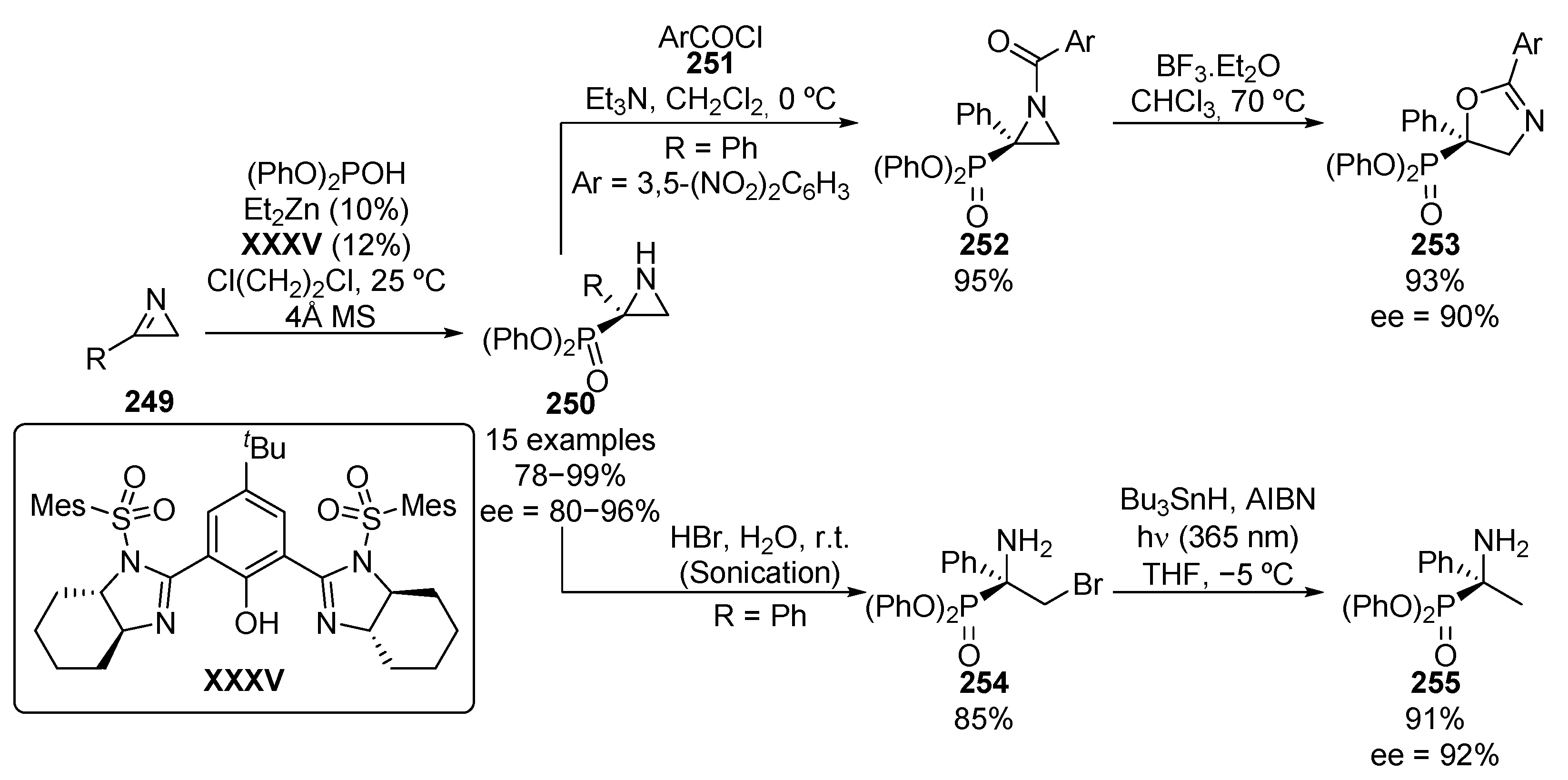




Publisher’s Note: MDPI stays neutral with regard to jurisdictional claims in published maps and institutional affiliations. |
© 2021 by the authors. Licensee MDPI, Basel, Switzerland. This article is an open access article distributed under the terms and conditions of the Creative Commons Attribution (CC BY) license (https://creativecommons.org/licenses/by/4.0/).
Share and Cite
Maestro, A.; del Corte, X.; López-Francés, A.; Martínez de Marigorta, E.; Palacios, F.; Vicario, J. Asymmetric Synthesis of Tetrasubstituted α-Aminophosphonic Acid Derivatives. Molecules 2021, 26, 3202. https://doi.org/10.3390/molecules26113202
Maestro A, del Corte X, López-Francés A, Martínez de Marigorta E, Palacios F, Vicario J. Asymmetric Synthesis of Tetrasubstituted α-Aminophosphonic Acid Derivatives. Molecules. 2021; 26(11):3202. https://doi.org/10.3390/molecules26113202
Chicago/Turabian StyleMaestro, Aitor, Xabier del Corte, Adrián López-Francés, Edorta Martínez de Marigorta, Francisco Palacios, and Javier Vicario. 2021. "Asymmetric Synthesis of Tetrasubstituted α-Aminophosphonic Acid Derivatives" Molecules 26, no. 11: 3202. https://doi.org/10.3390/molecules26113202
APA StyleMaestro, A., del Corte, X., López-Francés, A., Martínez de Marigorta, E., Palacios, F., & Vicario, J. (2021). Asymmetric Synthesis of Tetrasubstituted α-Aminophosphonic Acid Derivatives. Molecules, 26(11), 3202. https://doi.org/10.3390/molecules26113202








